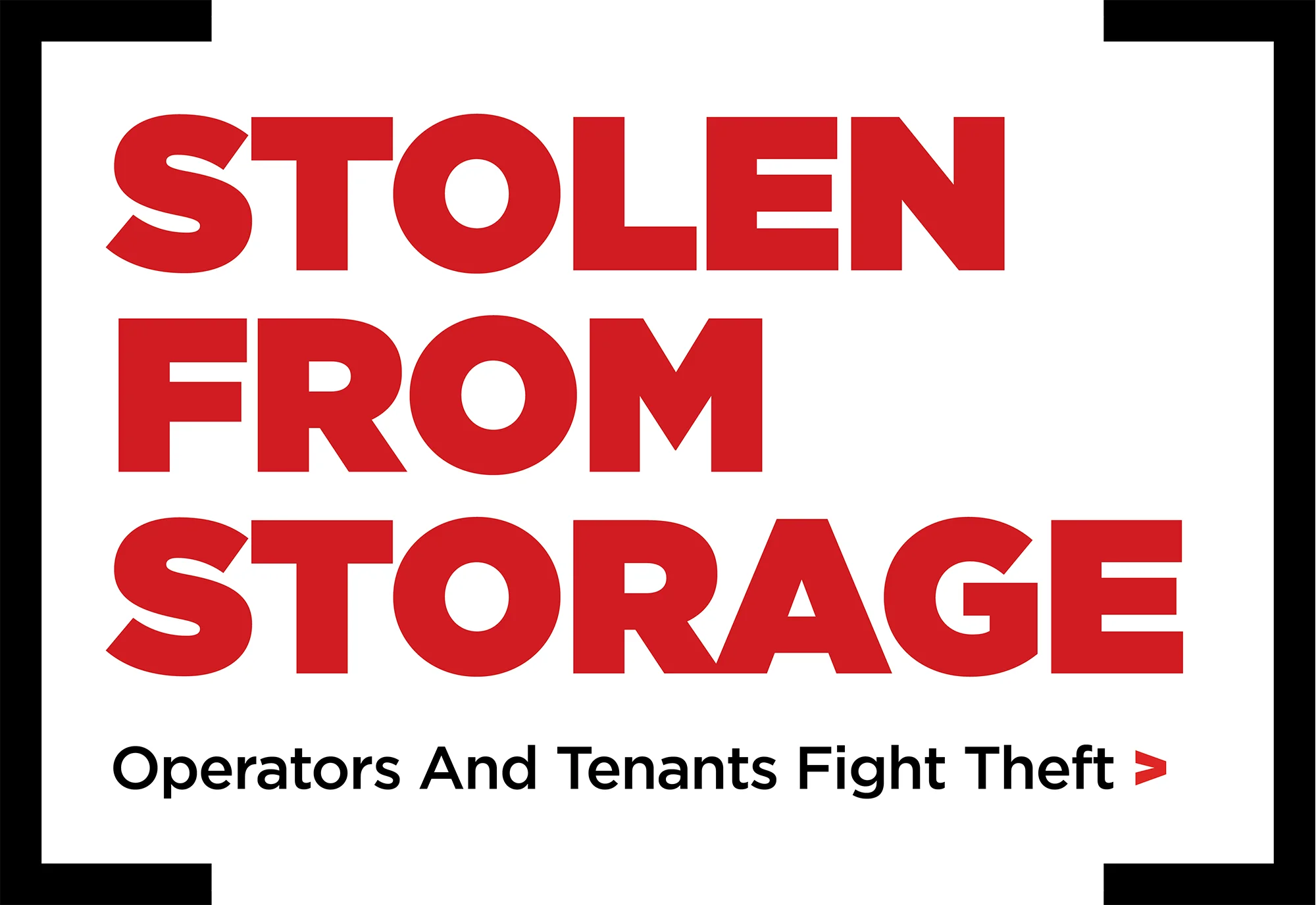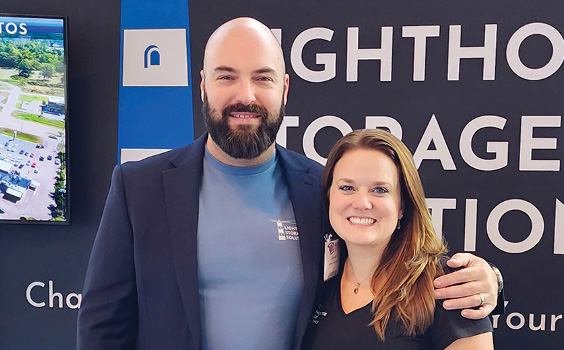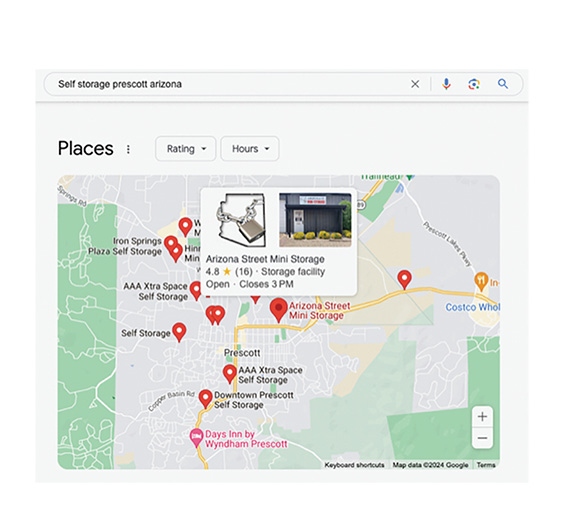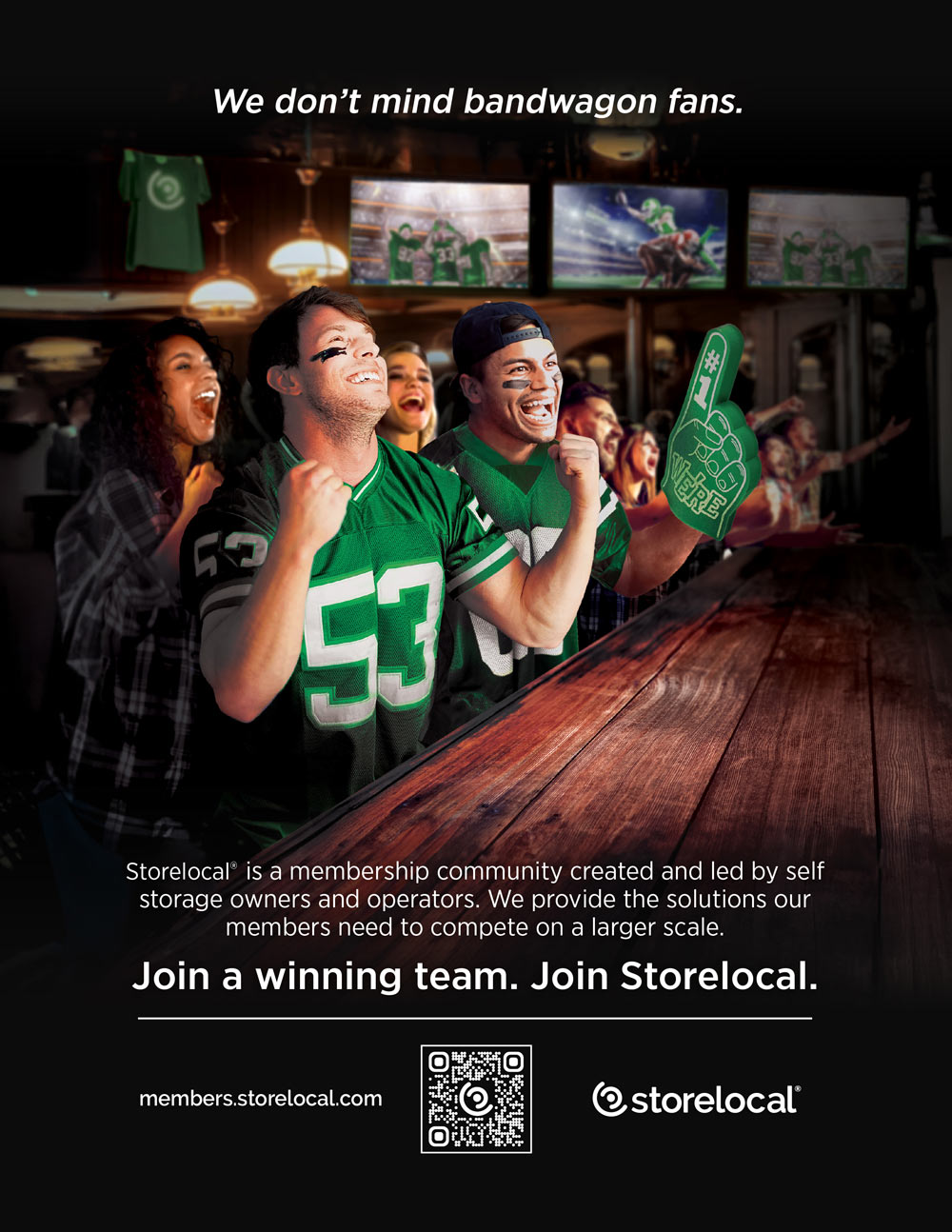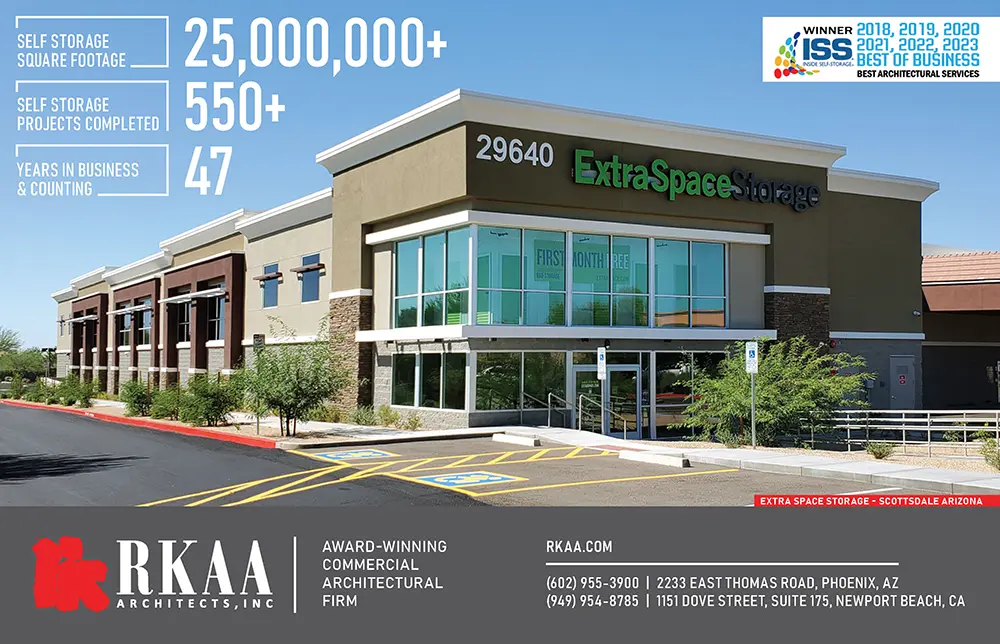How to enjoy our new magazine:
Just scroll!
Click or tap the table of contents icon in the menu bar to find any article.
Read any article by clicking or tapping the read full article button below each article intro.
Jump back to your previous browsing spot from any article using the menu bar or back to issue button.




- Meet The Team
- Editor’s Note by Erica Shatzer
- Women In Self-Storage: Ann Parham by Erica Shatzer
- Managers In Action: Amy Hooks by Ciera Rupp
- StorageGives by Josh Huff
- Believe It Or Not!
- Industry News


-
Web Manager / News Writer
Brad Hadfield
-
Storelocal® Media Corporation
Travis M. Morrow, CEO
-
MSM
Jeffry Pettingill, Creative Director
-
Websites
-
Publisher
Poppy Behrens
-
Creative Director
Jim Nissen
www.commandshiftoption.com -
Director Of Sales & Marketing
Lauri Longstrom-Henderson
(800) 824-6864 -
Circulation & Online Sales Coordinator
Carlos Padilla
(800) 352-4636 -
Editor
Erica Shatzer
-
Visit Messenger Online!
Visit our Self-Storage Resource Center online at
www.ModernStorageMedia.com,
where you can research archived articles, sign up for a subscription, submit a change of address. - Self-Storage Now! is published quarterly by MSM – PO Box 608, Wittmann, AZ 85361-9997. Unsolicited manuscripts, artwork, and photographs must be accompanied by an addressed, return envelope with the necessary postage affixed. MSM assumes no responsibility for the return of any unsolicited materials.
-
© 2024, Storelocal® Media Corporation. All rights reserved. Reproduction in whole or in part without written permission is prohibited. Printed in the United States.

We have put every issue through 2022 on our website, giving you free access to this wealth of knowledge.




Modern Storage Media



Messenger


elcome to the Q3 2024 issue of Self-Storage Now! If you haven’t already noticed, it has been upgraded in several ways. For starters, like MSM’s flagship publication Messenger, it’s now in a scrolling format and features numerous digital enhancements that elevate the reading experience, such as animated advertisements, audio, and video.
One such enhancement is included in “Believe It Or Not,” our new quarterly column that highlights shocking self-storage stories that are too outrageous to be fiction. Have you uncovered something unbelievable in one of your units? Has one of your tenants or managers done something truly bizarre? Do you have an atypical tale you’d like to tell? We’d love to hear it and share it with our subscribers! You can send it to me at Erica@ModernStorageMedia.com.
On another note, we hope you take notice of all the modern upgrades and new capabilities as you scroll through the magazine. For instance, you can easily share the content with others through Facebook, X, and LinkedIn. And for quicker navigation, you can simply click on the Table of Contents tab in the top right-hand corner.
Finally, I’d like to take a moment to remember Charlie Fritts, president of East Amherst, N.Y.-based SIMI (Storage Investment Management, LLC) and president of the Northeast Self Storage Association (NeSSA). In addition to being a devoted husband, father, and grandfather, Charlie was a longtime member of the former Self-Storage Now! advisory board. He was someone I came to rely on for insights about self-storage management and marketing, and he was genuinely generous with his time and words of encouragement. He will be missed by the entire MSM team and everyone who knew him. Thank you kindly for your countless contributions and your warmth, Charlie!
With gratitude and heartfelt condolences,

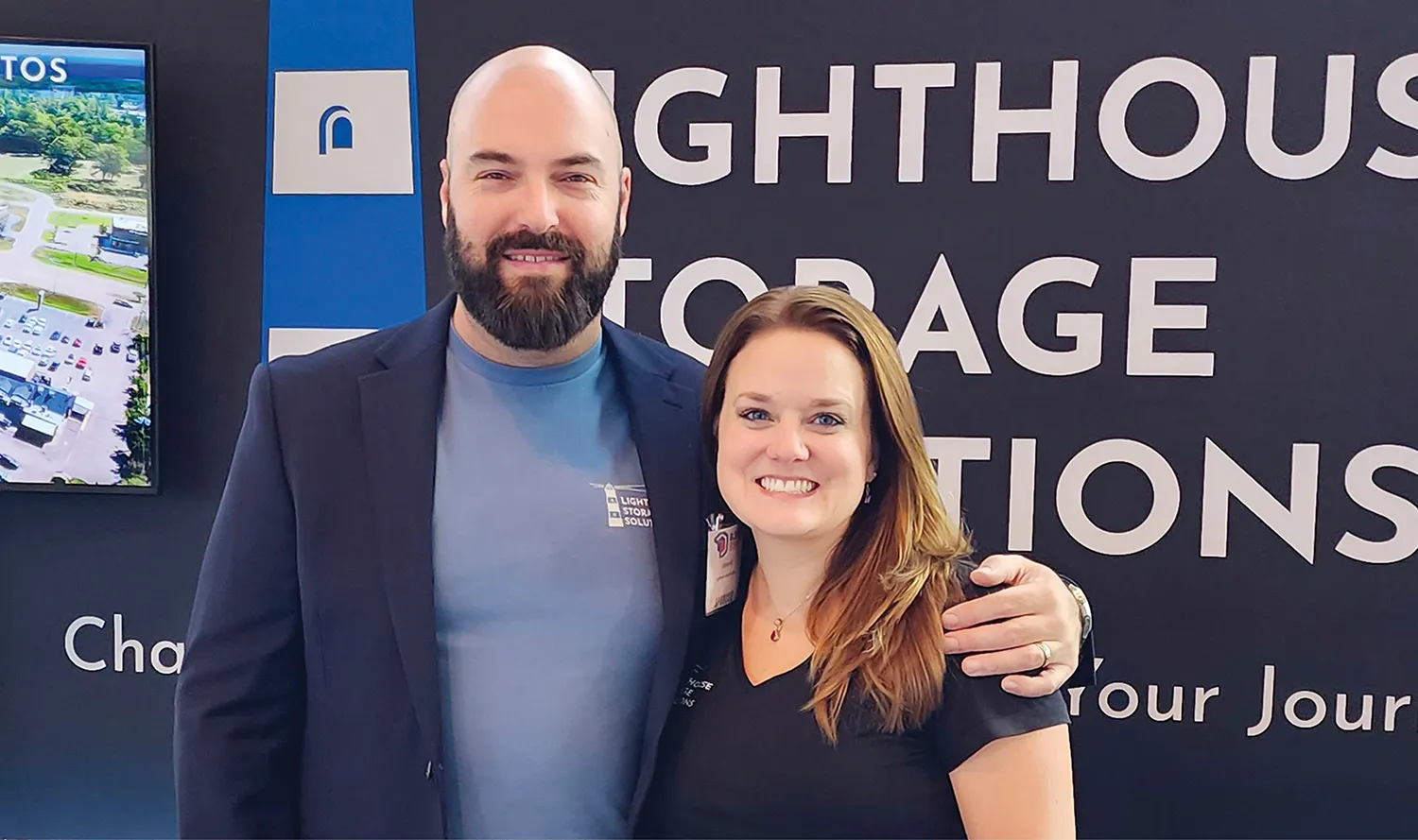
lot of marriages are put to the test at some point throughout the couples’ time together. For Josh and Melissa Huff, co-founders of Lighthouse Storage Solutions, it happened almost immediately. After dating for less than a year, the couple decided to marry in early 2020. Not only was it a big change for them, but they were also merging two families. (Josh has three daughters and Melissa has one son, all from previous marriages.)
The honeymoon was barely over when the world shut down. COVID entered the United States like a bull in a china shop, forcing the newlyweds into lockdown before the ink was even dry on the marriage license.
“It could’ve gone south very quickly,” laughs Josh. “Fortunately, that’s not what happened. In fact, it was a blessing being so close to one another and our kids during such a turbulent time.”
That wasn’t the only bright side to the situation. “It was also during quarantine that Melissa introduced me to the world of self-storage,” says Josh.
During the COVID quarantine, the couple was forced to share space in their home office. Again, this closeness was a blessing in disguise. “That’s when I started becoming interested in self-storage,” explains Josh. “I’d listen to Melissa talking about the business with clients, see the type of work she was doing … I already had years of experience in marketing, and thought, maybe there’s a place for my gifts in the self-storage world.”
He began by working on side projects for Melissa and assisting with marketing for the state associations she was overseeing. But he saw other opportunities on the horizon, so he started Lighthouse Storage Solutions. “At first the business was geared more towards self-storage vendors, but it quickly expanded to owners/operators as their needs grew, and especially as the pandemic eased,” says Josh. “A number of facilities that had been doing unprecedented levels of business suddenly found themselves struggling, so [I] began looking at ways to help them with marketing, web design, and drone photos and video.”
A month later, Melissa joined the team, making it a full-service operation to “guide owners on a clear path towards their desired destination.”


Josh explains that while he focuses on marketing and the customer-facing aspects of client businesses, Melissa is on the backend, offering self- storage consulting, employee training, procedure manuals, and business valuation and optimization services. She is also a prolific speaker, often taking the stage at state and national shows to discuss the industry. “I love speaking at industry events and contributing to industry publications,” says Melissa. “And I am always happy to talk with owner operators and managers about their business. Self-storage really is a passion.”


“I couldn’t be happier with the ways things turned out; God has truly blessed us,” says Josh. “The work is great, but working together is even better. Our jobs take us all over the country, and we always make time for fun on those travels.”
“We’re a team, in business and in life,” adds Melissa. “We celebrate every win together.”

One of the more unique services that Lighthouse Storage Solutions offers is drone video footage. Josh, an FAA-licensed drone pilot, travels the country to take aerial photos and video of storage facilities that owners can use on their websites and promotional material to highlight their property from above.
“Drone photos and video are valuable tools to tell the story of your self-storage facility and to give operators a way to showcase their properties to potential tenants,” says Josh, who, along with his wife Melissa, regularly features drone videos at the company’s trade show booths to get people excited about them.
He says that other facility owners also like to watch the videos as it gives them a way to create a wish list for their own property. “They can easily see how other facilities are laid out, the landscaping, color and design options, and more.”
While some owners may be tempted to create their own drone videos, Josh recommends hiring a professional. “The FAA license is no joke,” he explains. “To get it, you learn about regulations for flight, weather patterns, safety around buildings and people. It’s really like learning how to fly a small plane. If you don’t know what you’re doing with a drone, don’t do it.”
View one of Josh’s most recent compilations of self-storage drone footage by clicking on the video above.

hen people think about self-storage facilities, a manager cruising around in a golf cart checking locks, showing units, and keeping things secure may spring to mind. The downside of that is what many prospective renters also know of self-storage communications: a busy tone or a voicemail apologizing for the inability to get to the phone, often within already limited business hours that coincide with most prospective renters’ own busiest periods.
“The ability to rent a unit online was few and far between before COVID,” says Jennifer Downer, COO at XPS Solutions, with 24 years of experience in remote management for self-storage property owners. “Many operators were forced into action to accommodate prospective tenants.”
Out of necessity arose a boon of options to switch to online reservations and automation.
“Self-storage in general is a little old school,” says Sneha Elizabath Jose, product manager of Mariposa and Synergy at Tenant, Inc. “A lot of people are used to doing it the traditional way. There was a bit of change management for them to move to an online platform. They might even feel like, ‘Oh, my job is gone.’ We set the expectation. Your job is not over; it’s just done in a better way so you can concentrate on more important things within your business.”
This change in attitude has improved efficiency for owners and service through convenience for customers.
“After launching self-service kiosks in the early 2000s, OpenTech recognized its future in modern self-storage and went all in to help companies connect with tenants, simplify their operation, and grow their business,” says Kristi Adams, vice president of marketing for OpenTech Alliance. “With innovations that reset industry standards, we’ve built a robust property technology company with a portfolio of 10-plus products to provide practical solutions to tenant and operator challenges.”


“One financial pro is that it frees up your management to focus on other revenue-generating endeavors like marketing and collections,” says Downer. “It may also allow you to reduce overhead by adjusting office hours and payroll. A financial con would be the cost of ‘paying to play’ online. Just as you would want to be the first person to answer the call of a prospect, you also want to be the first facility online that can answer the need of the prospect, or they will move on to the next location.”
Greater access to customers leads to higher levels of business being accomplished.
“Pros consist of 24/7 availability of potential customers to make reservations at any time leading to increased occupancy,” says Adams. “You also now have a paperless process you have automated, saving on time and labor.”
“From my standpoint, the benefits far outweigh the challenges,” says Jose. “Our websites show inventory to a much larger audience, and they can tailor campaigns or ads and then put them on Google, put them on YouTube. If customers are searching for self-storage, those ads pop up and then they can click and get a promotional rate versus walking into the store. The tabs on the top of listings are created to showcase whatever feature or amenity you offer, such as climate-control units, and clicking creates a unique URL to use in blog posts. Anyone coming through that blog post sees a filtered view of climate-control units. We can see where customers are coming from on the backend, giving us a powerful marketing tool that shows companies exactly where they should spend their money. The only con I see is that we are capturing customer data, so it’s very important to ensure the data is secure and it’s not exposed to any breaches or cyberattacks.”
“Technology is great until it isn’t,” says Downer. “If your property management software is integrated with your website, it is critically important that the data within it is accurate. For example, if a tenant reports they have moved out, and that unit is put back into service without checking it, it is possible that it could be rented online but still full of items. On the contrary, allowing rentals online in essence extends your office hours by allowing prospects to rent and even move in outside of normal office hours.”
There always needs to be balance of convenience versus personal service in adding automation to a business.
“Cons are very few, but some that come to mind are removing the personal touch that many operators pride their business on,” says Adams. “You can only communicate so much about how you differentiate on a website rental flow. However, customers often prefer to do things at home over the phone or online versus having to come into the office during a busy moving season in their life. In that aspect, you are enhancing the overall experience they have with self-storage.”


“Fully automated facilities are no longer the future; they are the now for many operators, as the model offers significant benefits in terms of operational efficiency, scalability, and customer convenience,” says Adams. “Online reservations with a rental completion at the facility via a kiosk where you can capture a picture of the tenant, get a driver’s license scan, and sign the lease completes that entire fully automated model.”
“There are already many operators who have fully automated facilities,” says Downer. “Partnering with a vendor that offers remote management solutions is the ideal way to do so.”
A major benefit to bringing automation to facilities is lowering the break-even point, allowing for smaller properties to exist that could not have supported the cost of a manager’s salary. This enables owners and investors the opportunity to move into key locations ideal for the storage market that might have otherwise been too small in square footage to work out financially.
“One fully remote group Mariposa serves comes to mind,” says Jose. “They have one manager for five or six properties. They do not have managers in the individual properties. Customers can go onto the website or app, make a reservation for their rental, get a code for the electronic gates on the property, walk in and show their pin on the mobile app to enter the building, go to their unit again opening it with their app, stow their belongings, and come out leaving their goods secure, without having to talk to anyone. This business started with a small, single property. They then were able to open two or three more locations, and now they are constantly expanding—all because they can do this using online reservations and the storage software. They couldn’t afford to have managers in each location, but using tech they can easily manage a big portfolio remotely.”
While some large corporations are going all in on bringing high-end online reservations to the storage space, many software companies offer a variety of plans at different price points, giving smaller operations a path to join the game. Tech can also help prioritize mom-and-pop operators’ time for the more personal touch of handling face- to-face customers.
“AI Chatbots can handle customer inquiries,” says Adams. “It can guide them through the reservation process and provide instant responses, reducing the need for human intervention.”
“Consider your market and your facilities KPIs. If your facility has low occupancy and high ARs, it may be best to clean that up a bit before going fully remote, or partner with a vendor that has experience with those factors.” –Jennifer Downer
“Utilize every possible avenue to secure customers this rental season. This includes having a call center to ensure no calls are missed, a website and mobile app that are intuitive and easy to navigate with online reservation functionality, and a kiosk to complete the full-service rental experience.” –Kristi Adams

n the self-storage industry, 2024 has ushered in a challenging landscape where fluctuating rates and occupancies below our accustomed levels necessitate a return to fundamental strategies. As many operators engage in aggressive pricing tactics to attract customers, it becomes imperative to reassess the core metrics that drive operational efficiency and success. Each year, for the past 25 years, M. Anne Ballard, Universal Storage Group’s president of marketing, training, and developmental services, has compiled data from our managed and consulting sites, as well as from industry experts and publications, to present the year-end review. This year, Lou Barnholdt and I aided her in gathering and interpreting the data to carry the torch going forward and continue this highly anticipated presentation. In it, we showcase many of the metrics our managers and area managers evaluate on a daily, weekly, monthly, or yearly basis. These metrics are essential for continually growing our owners’ same-store sales and net operating income (NOI). By homing in on these essentials, owners can navigate the current market dynamics with greater precision and resilience. While there are numerous metrics to consider, let’s get back to the basics with 10 of the management metrics that spell success: same-store sales increase (SSSI), net operating income (NOI) increase, gross potential, street rates, insurance sales, box sales per lease, fees waived, delinquent percentage, economic occupancy, and customer rates. It’s important to note that the names of the reports I reference may vary depending on the software you use, but the process remains the same.
Next on the list is late fees. Calculate the ratio of your collected late fees and other fees to your waived late fees and other waived charges. This ratio should be less than 10 percent. By keeping waived fees below this threshold, you ensure effective fee management and maintain revenue integrity.


“Fully automated facilities are no longer the future; they are the now for many operators, as the model offers significant benefits in terms of operational efficiency, scalability, and customer convenience,” says Adams. “Online reservations with a rental completion at the facility via a kiosk where you can capture a picture of the tenant, get a driver’s license scan, and sign the lease completes that entire fully automated model.”
“There are already many operators who have fully automated facilities,” says Downer. “Partnering with a vendor that offers remote management solutions is the ideal way to do so.”
A major benefit to bringing automation to facilities is lowering the break-even point, allowing for smaller properties to exist that could not have supported the cost of a manager’s salary. This enables owners and investors the opportunity to move into key locations ideal for the storage market that might have otherwise been too small in square footage to work out financially.
“One fully remote group Mariposa serves comes to mind,” says Jose. “They have one manager for five or six properties. They do not have managers in the individual properties. Customers can go onto the website or app, make a reservation for their rental, get a code for the electronic gates on the property, walk in and show their pin on the mobile app to enter the building, go to their unit again opening it with their app, stow their belongings, and come out leaving their goods secure, without having to talk to anyone. This business started with a small, single property. They then were able to open two or three more locations, and now they are constantly expanding—all because they can do this using online reservations and the storage software. They couldn’t afford to have managers in each location, but using tech they can easily manage a big portfolio remotely.”
To maintain a well-balanced operation, it is essential to measure three types of occupancy metrics: the percentage of occupied units, the area percentage, and the actual occupied unit rates (economic occupancy). Ideally, these figures should align closely with one another. Regularly monitoring and ensuring these occupancy rates are in balance will contribute to more efficient and effective property management and use of the units you have to offer.
- Frequent Communication – Call delinquent tenants two to three times a week to remind them of their overdue balances.
- Automated Reminders – Invest in services that send text notices to tenants, allowing them to pay with a simple click.
- Online Auctions – Partner with an online auction company and hold monthly auctions to recover losses.
- Settlement Agreements – Be open to accepting settlement agreements (preferably 50 percent or more of their balance) to resolve overdue balances quickly, and then move them out.
These proactive measures can help maintain financial health and reduce the burden of chasing down delinquent payments.
Several factors should influence the decision on rate increases, such as occupancy levels and variance amounts. For those new to managing this aspect of income, implementing increases in batches is advisable. Not everyone will be pleased with the rate hike, so it’s essential to empower your manager to negotiate with customers, while still maintaining the increase to some extent.
It’s crucial to monitor customer rate increases monthly and keep a daily check on street rates. Although this might seem time-consuming and tedious, software tools are available that can automate rate scraping and allow you to set parameters for automated adjustments, making the process more manageable and efficient.
By adopting a more systematic approach, you can ensure fair and gradual rate adjustments that contribute to customer retention and satisfaction. Empowering your management team with the authority to handle negotiations can also mitigate potential dissatisfaction, ensuring a balanced approach to revenue management and customer service.
These metrics are just the tip of the iceberg. Regularly analyzing them keeps your business on a growth trajectory and highlights areas needing improvement. Owners and managers must understand key performance metrics and their implications. Continuous learning through industry publications, webinars, and association meetings is invaluable. For more insights into these and other metrics, visit our website, UniversalStorageGroup.com, and read the 2023 Review under the Resources tab. Here’s to a prosperous 2024!

hy is Your Google Business Profile (GBP), formerly known as Google My Business, important? First and foremost, GBP is directly connected to Google Maps (see Image 1).
A potential customer may search for “self-storage near me.” This is the person who needs storage for a multitude of reasons but lives or works in your neighborhood. Of course, you don’t need to put the words “near me” on your profile or website. Google will know based on the searcher’s GPS location, and it will pull up all the facilities matching the criteria based on their Google Business Profile.
People may also search for “self-storage in [your town or city].” This could be someone who’s relocating. At any rate, your exact address needs to be the same everywhere—not just in your GBP.
Additionally, in your GBP, you can highlight all your services, amenities, and products, as well as post your hours. Customers can leave reviews. Potential customers can ask questions like “Can I store my car?” You can post tips, blog posts, and even promote events like auctions.
Furthermore, you can brand your page by uploading your logo and images (see Image 2).
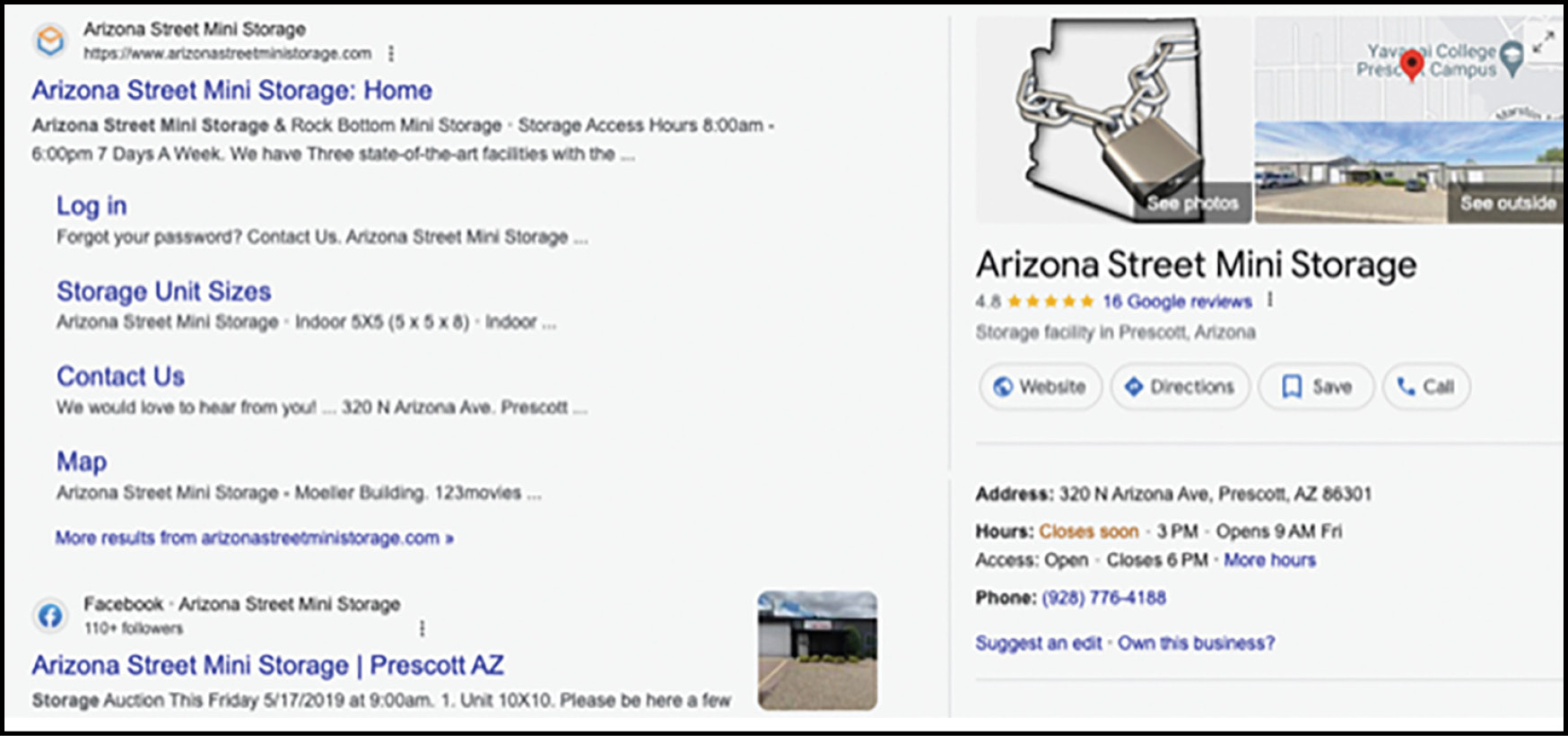



If you’re new to your location, you will have to verify your business. Follow the prompts and instructions to get verified. Once you’re verified, you’ll get a blue checkmark on your logo. By the way, this is what my GBP Dashboard looks like. (See Image 4)
On your profile, when you click on the three dots to the right of “Profile Strength,” you’ll see your business profile settings. (See Image 3) The business profile settings is where you can add other managers to your profile. I recommend having at least two people with access to your profile. Set notifications as needed; you want to be notified when someone asks a question and when someone posts a review—good or bad. As for “add a new business profile,” that would apply if you have multiple locations.

Here’s is where you add the pertinent details of your facility (see image 5). Make sure all your information is current: business name, contact information, regular hours, holiday hours, facility amenities, languages spoken, and services provided. Fill out everything that is relevant to your facility.
Believe it or not, all of this is important. Go through each of these sections and make sure that everything is filled out and optimized with your relevant keywords. For instance, you get 750 characters for your description. Make it keyword-centric, but don’t overdo the keyword stuffing. Write for your potential customer, in natural language, with the search engine in mind.

Another nice feature is “Updates” (see Image 6). You can share blog articles from your website to help with SEO. Add special offers and promote your events, especially your auctions.

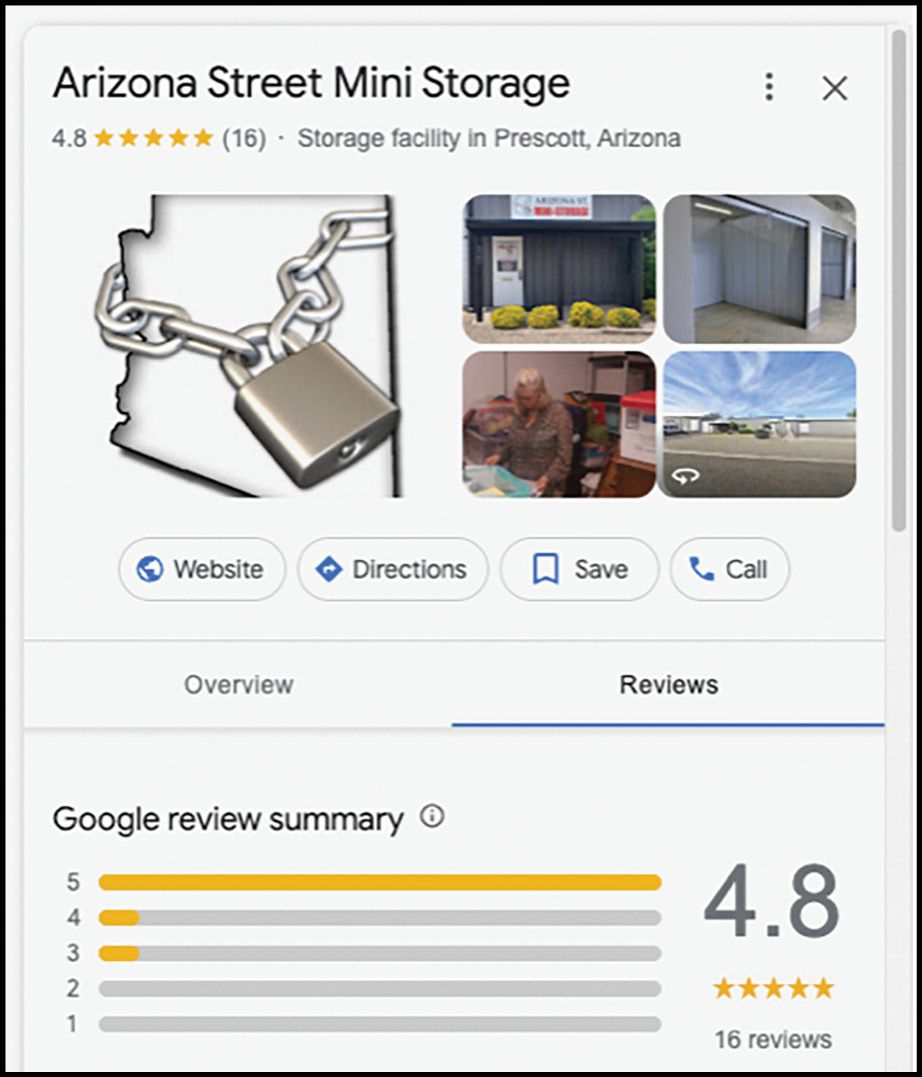
Always check your reviews and respond to them. Thank a happy customer and defuse any unhappy ones (see Image 7).
This tracks interactions on your business profile only—not on your website. It will tell you how many people clicked over to your website from the profile. Note: This is not Google Analytics! That’s a different setup. (Refer to my past article on analytics.) If you have your phone number listed, which you should, it will tell you how many calls came from the profile (and messages if you have them turned on).


There are two types of suspensions: hard or soft. A hard suspension is when your business profile doesn’t appear when you Google your business name and city. This is bad. This may happen when there’s a change in management or ownership, or when an employee leaves and takes all your passwords with them. Another possibility is that your business is “unverified.” Google may have suspended you if it thinks your business is closed or you’re using spammy tactics.
A soft suspension is when your profile comes up and you have access to your dashboard but it looks like it’s never been verified as a local business and you can’t manage or update your listing. How do you know if your profile was suspended? More than likely, you received an error message or email saying something like, “Your access has been suspended (or disabled) because this profile doesn’t follow the guidelines …” They should provide a button for you to be able to edit your profile and fix the problem.
They also may send you an email saying, “Your business profile has been suspended for [violation type] content that violates our policies on deceptive content and behavior isn’t allowed. Deceptive content intentionally misleads or deceives others.” You’ll see an “Appeal” button to appeal the violation. Most times they won’t tell you about the offense. It’s up to you to determine what it was and avoid doing it again. You must fix what’s wrong before you submit your appeal.
It’s possible that you’ve been overzealous in your posting and Google thinks you’re spam. Maybe something you posted offended someone with a lot of clout. Don’t be surprised if a competitor is behind bad reviews or reports your facility.
It’s also possible you accidentally created more than one listing for the same location. In this case, disable the one that’s less complete. By no means should you create a new listing if your current one was suspended! Make sure any managers of your listing(s) are in good standing with Google. Finally, don’t violate any of Google’s terms of service (https://support.google.com/business/answer/9292476?hl=en).
All in all, your Google Business Profile should complement your website. You need both. The GBP is limited in the amount and type of information that you can include, thus your website can provide details.
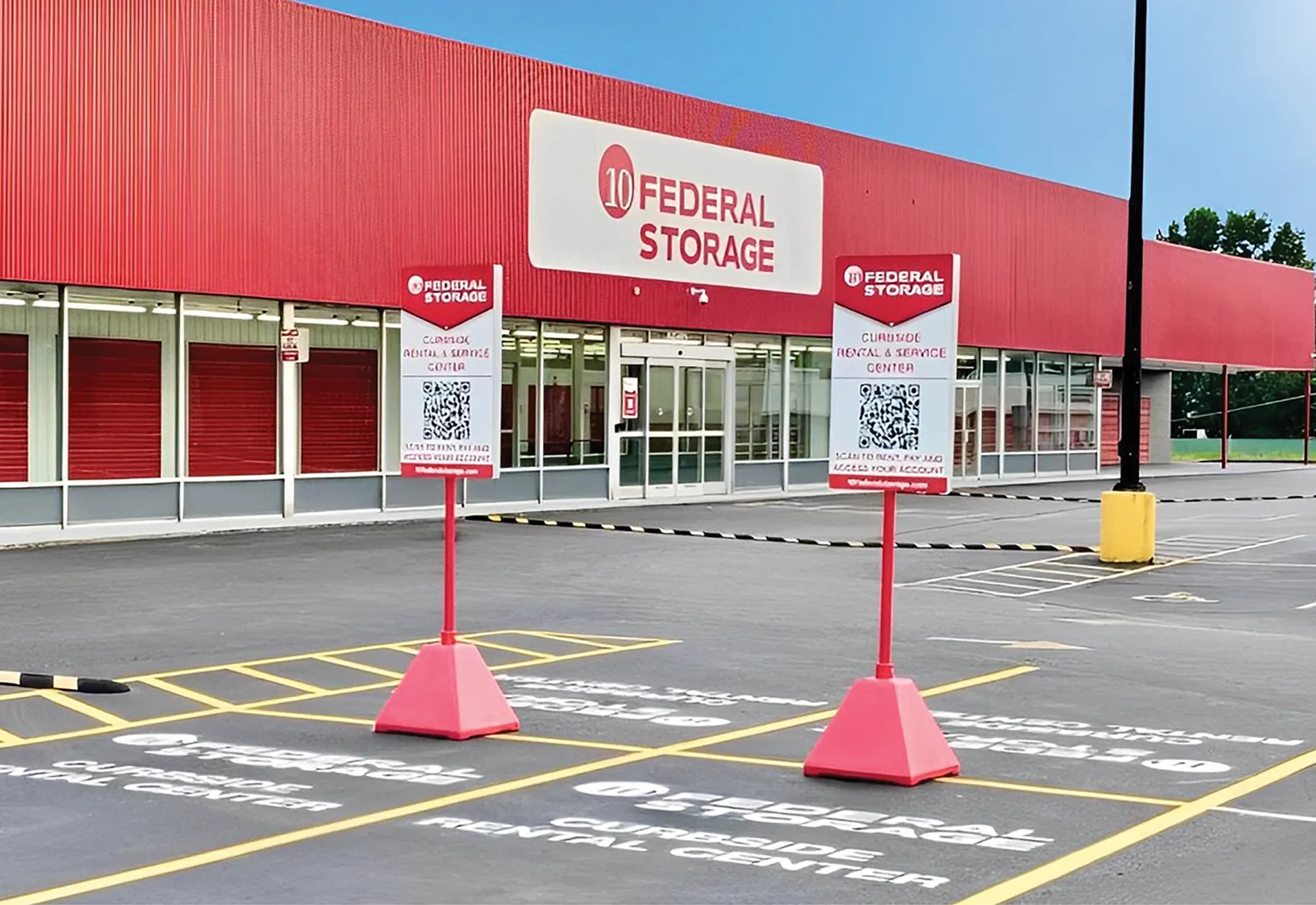
he pandemic has had some lasting effects, and not just on our national psyche. For one, it brought back the languishing QR code, which marketers had never quite known what to do with, to replace handheld menus. It also ushered in the already burgeoning concept of curbside pickup, allowing customers with a vehicle to completely avoid stepping foot in potentially crowded stores. And while COVID may have necessitated the use of both, the convenience each provided meant that although COVID would eventually go away, QR codes and curbside pickup would remain.
One self-storage company that isn’t afraid to be a little disruptive in the industry is 10 Federal Storage, which operates 20,000-plus units at more than 75 locations across 14 states. From fully automated locations to the use of security drones, the company often looks for new and innovative ways to improve the customer experience, whether it’s to offer more convenience or provide more safety. Now, 10 Federal has launched its new “Curbside Rental & Service Center” concept for its owned and managed properties.

Similar in look to other curbside pickups but bolstered by complex tech being the scene, customers pull in within their vehicle, scan a QR code to access a portal, and then they can instantly rent a unit, manage their account, pay bills, get their access gate code and DaVinci Lock unlock code, report issues, and even move out.
Capranos says that he and his team had been exploring the idea for a while. Although most curbside service is found in retail and restaurants, they didn’t see why the concept couldn’t be applied to self-storage. “We already use self-serve storage kiosks, so why not take it a step further?”
Capranos’ instincts were right; according to eMarketer, 62 percent of shoppers in the U.S. now expect businesses to have some sort of curbside service. The outlet expects these “click-and-collect” buyers to grow to 150 million by the end of 2024, representing 53 percent of the population. “The ability to offer curbside service is key to a customer experience for the modern-day shopper,” says Salesforce’s Michelle Grant, senior manager of strategy and insights. “Consumers have become addicted to convenience in all aspects of their life. And this is the most convenient way of fulfillment for those who have a car, which is a lot of Americans.”
“We did do our research though,” says Capranos. To understand customer needs for such a service, 10 Federal had a disposition tool built for their call center to determine the main reasons people would call in. After a period of monitoring calls, he says they knew the majority that came in could be handled through a curbside service.



Comparisons to a kiosk are also quickly thrown out the window. “With a kiosk, you have to go into the store—maybe in the snow, heat, or rain—and input your information on someone else’s device. Why do that? Everyone has a thousand-dollar kiosk in their pocket—their phone! People can stay in the safety and comfort of their car, use their own phone, and save time because it’s likely to auto-populate your information and payment details.”
The portal also includes 10 Federal’s built-in AI-powered chatbot, which can handle 85 percent of all inquiries without human intervention. “This has led to a significant drop in our call volume in our call center,” continues Capranos. “Since implementing the Tenant Connect portal, calls are down about 50 percent compared to last year, and we’re having one of our best rental seasons ever.”
He is quick to point out that if a customer does need a human touchpoint, that option is available. “If the bot can’t help, it’ll direct them to an agent, or they can just request a live agent for additional assistance.”
Capranos believes that as the idea catches on, they’ll also save money on kiosks. “If a customer is using their own phone, eventually you don’t need that kiosk. You don’t need that office. Think about the savings there. Plus, it’s super easy to update it when needed since it’s a web-based technology.”


In a traditional facility, the auction buyer would simply go to the counter and get it back from the property manager. But in an automated facility, they need to reach the call center and begin processing a refund that way.
“Now, with this new feature, they can just put in their phone number, upload a photo of their unit, and it will refund them their auction deposit once the unit’s cleaned out,” says Capranos. “This has helped reduce abandoned goods on our properties and get our units cleaned out a lot faster after an auction.”
“Modern consumer expectations are driving the evolution of self-storage. Our new Curbside Rental & Service Center is designed to meet these changing needs, offering unparalleled convenience and efficiency,” says Capranos. “But we won’t stop there. We are dedicated to enhancing customer experience and operational efficiency and finding new and innovative solutions in the self-storage industry.”

elf-storage operators wear a lot of hats. On any given day, they may play the part of customer service representative, accountant, repair tech, auctioneer, negotiator, marketers, and crime fighter. While that last one may not be true of all operators, more and more within the industry believe it is a necessary role.
“If you’ve been in storage, then you know break-ins are unfortunately a normal occurrence,” says Taylor Pierce, executive director for Great Oaks Capital Partners, LLC. “We need to partner with our tenants and nearby storage companies if we want to make a difference. If we put the same effort into theft like we do our existing customer rate increases (ECRIs), we’ll see a difference.”
But is self-storage theft that big of a threat to the industry? Some might argue that there are more than 50,000 self-storage facilities in the United States, with the average facility comprising 545 units. Therefore, when you consider the sheer number of units (around 27 million), the amount that are broken into is relatively small.
Gabriel Tushim, senior director of sales with OPTECH Integrated Technology Solutions, feels this is a form of data manipulation. “I don’t think you should be looking at the number of units but at the number of facilities. That’s when you can see that theft is becoming a big industry issue.”
Another reason data doesn’t tell the full story is because self-storage thefts often fall under the “hotel rule” of the FBI’s Uniform Crime Reporting (UCR) Handbook. This rule is used to reduce the burden of reporting burglaries of temporary lodgings, stating that if a number of dwelling units under a single manager are burglarized and the offenses are most likely to be reported to the police by the manager rather than the individual tenants, the burglary should be scored as one offense.
“This means that if a burglar hit 20 units at one location and the manager calls the police, the number of burglaries reported will be one,” explains Justin Insalaco, a retired police officer, strategic advisor to the Atlas One law enforcement safety network, and a board member with Crime Stoppers Global Solutions. “Reporting also uses the concept of ‘same time and place,’ which means that if the same person or group of persons committed more than one crime and the time and space intervals separating them were insignificant, all the crimes make up a single incident.”

“The most common way that thieves break into a storage unit is by grabbing at the bottom center of the door and doing a dead lift, bending the door up,” explains Kellen Anderson, director of sales at Trac-Rite, who recommends self-storage owners look for doors that offer some type of reinforcement so that this can’t easily be accomplished. “They poke their head underneath, and if they see something they like, they either keep bending it upwards or they then cut the lock.”
“If you put on your ‘criminal hat’ for a moment, it’s easy to see why self-storage facilities are attractive to thieves,” says Maggie Bode, director of business development for DaVinci Lock. “They are vast with only a handful of individuals on site at any given time, and hundreds of units present hundreds of opportunities for theft. Plus, they’re also often on the outskirts of town, meaning police response can be slow.”
Christine DeBord, chief commercial officer at Janus International, agrees that the prospect of simply hopping a fence and cutting a lock can be far more attractive to thieves than breaking into a home where neighbors, occupants, alarms, and proximity to police could pose a problem. However, she notes that theft could also come from inside the property. “Someone could pose as a tenant to gain access to the facility,” she says. “Or, an employee or existing tenant may see someone loading something valuable into a unit and return later to snatch it up.”
However a thief gains access, police across the country are warning that self-storage thefts are on the rise. In Arapahoe County, Colo., for example, sheriff’s office investigators say there has been a rapid increase in storage facility thefts, with 60 occurring in the first six months of the year alone. “We’ve never seen it happen at this level before,” said Sgt. Brett Cohn. “The uptick started during COVID and hasn’t stopped. We need to educate the public and take away the opportunity for these types of crimes. It’s the only way it’s going to stop.” Modern Storage Media also reported on a facility in Colorado Springs in which police had responded to nearly 30 calls in three months.
WSMV4 in Nashville, Tenn., recently investigated security issues at storage facilities, combing through a year’s worth of data from the Metro Nashville Police Department. According to their investigation, more than 75 percent of the nearly 100 storage facilities they checked had calls for theft, holdups, robberies, or burglaries. One facility had 12 units hit at the same time in one month, another six were broken into less than two weeks later, and 20 more had items stolen from them just a few months after that.
Colorado and Tennessee aren’t the only states with a self- storage theft problem. According to Xercor Insurance Services, Kentucky, Texas, and California round out the top five, however it is a national problem.

Insalaco believes a shortage of police officers is one reason for this. “Less manpower on the street means more petty theft,” he says. “But bail reform also plays a part.”
Bail reform was designed to ensure that non-violent criminals are not detained simply because they can’t afford bail, promoting fairness and reducing unnecessary pretrial incarceration. By allowing them to maintain employment, housing, and family ties, the thought was that these non-violent criminals would be less likely to reoffend. However, the Department of Criminal Justice reports that eliminating bail for select misdemeanor and nonviolent felony charges led to little change in recidivism.
“How a case is prosecuted is up to the discretion of the prosecutorial agency,” says Steve Lieberman, founding partner with the Law Offices of Lieberman & Taormina, LLP, one of the nation’s leading attorneys specializing in firearms law, self- defense, and home invasions, and co-owner of the Artemis Defense Institute. “In some jurisdictions DAs [district attorneys] have taken the position that each unit represents an individual crime against the renter. Others have taken the collective view and essentially relied on the theory that this should be a civil matter between the renter and the storage facility owner. There is no hard and fast rule.”
Because there are no hard and fast rules, Insalaco says theft charges are typically a low priority. “Let’s not forget that prosecuting attorneys are elected officials,” adds Insalaco. “They all want the high-profile cases that are going to help them get re-elected. Storage theft is not really a compelling story, and they may just want to get it off the docket quickly, so it becomes a game of ‘catch and release.’”
Nearly 12 years ago, Marshall Calvert, a revenue management analyst at Crescendo Properties, was overseeing a Public Storage facility in Las Vegas. The property had become a target for one thief, who had broken into dozens of units in the area–76 to be exact–and made off with hundreds of thousands of dollars worth of belongings. Despite Calvert’s pleas to local police to do more, the crook remained on the loose. “I’d had it,” says Calvert. “So, I took it upon myself to randomly drive into facilities when he was known to strike, somewhere between 3 a.m. and 5 a.m.”
As fate would have it, Calvert eventually encountered the man, who was also armed. “I called the police, and this time they came quickly,” he recalls. “After a bit of a standoff, they were able to subdue him and get him off the property.”
Calbert says that despite this, the thief almost got away with it. “The guy had people stating he was only there this one time, including his girlfriend,” he explains. However, Calvert and the district attorney were able to scare the girlfriend into talking by claiming to have evidence that would prove she was lying under oath and liable to get 10 years for it. “She freaked out and started screaming that he had made her lie for him and admitted that she was storing all the property at her house for him,” continues Calvert. “The DA walked back inside the courtroom, and about 30 minutes later came back out and said they made a deal and that his sentence would be in the double digits.”
Self-storage operators aren’t the only ones fighting back; sometimes tenants do some sleuthing too. Just recently, a thief had been hitting a SmartStop Self Storage facility in Homestead, Fla. One of the tenants, who asked not to be identified, said that he’d had nearly $25,000 worth of belongings stolen from him. He’d filed a police report but the criminal hadn’t been caught.
Fed up, the tenant decided to stake out the facility on his own. The morning of the 4th of July, the thief returned, but this Independence Day heist cost him his freedom. Through the facility’s large windows, he was spotted breaking into numerous units. “We noticed that the individual was actually [going] from unit to unit,” said the tenant. “The technique that he used was actually [climbing] through the ceiling.”
Witnesses filmed it all on their cell phone, even catching a moment when the burglar got stuck in the ceiling and came crashing back down to the floor. Homestead Police officers soon took center stage, capturing the crook and taking him away in handcuffs. He faces several charges, including burglary, grand theft, and resisting an officer without violence.
Of course, it’s not always safe for owners or tenants to take matters into their own hands, nor are they likely to luck out with a girlfriend who sings like a canary or a crook who puts on a window show in broad daylight.
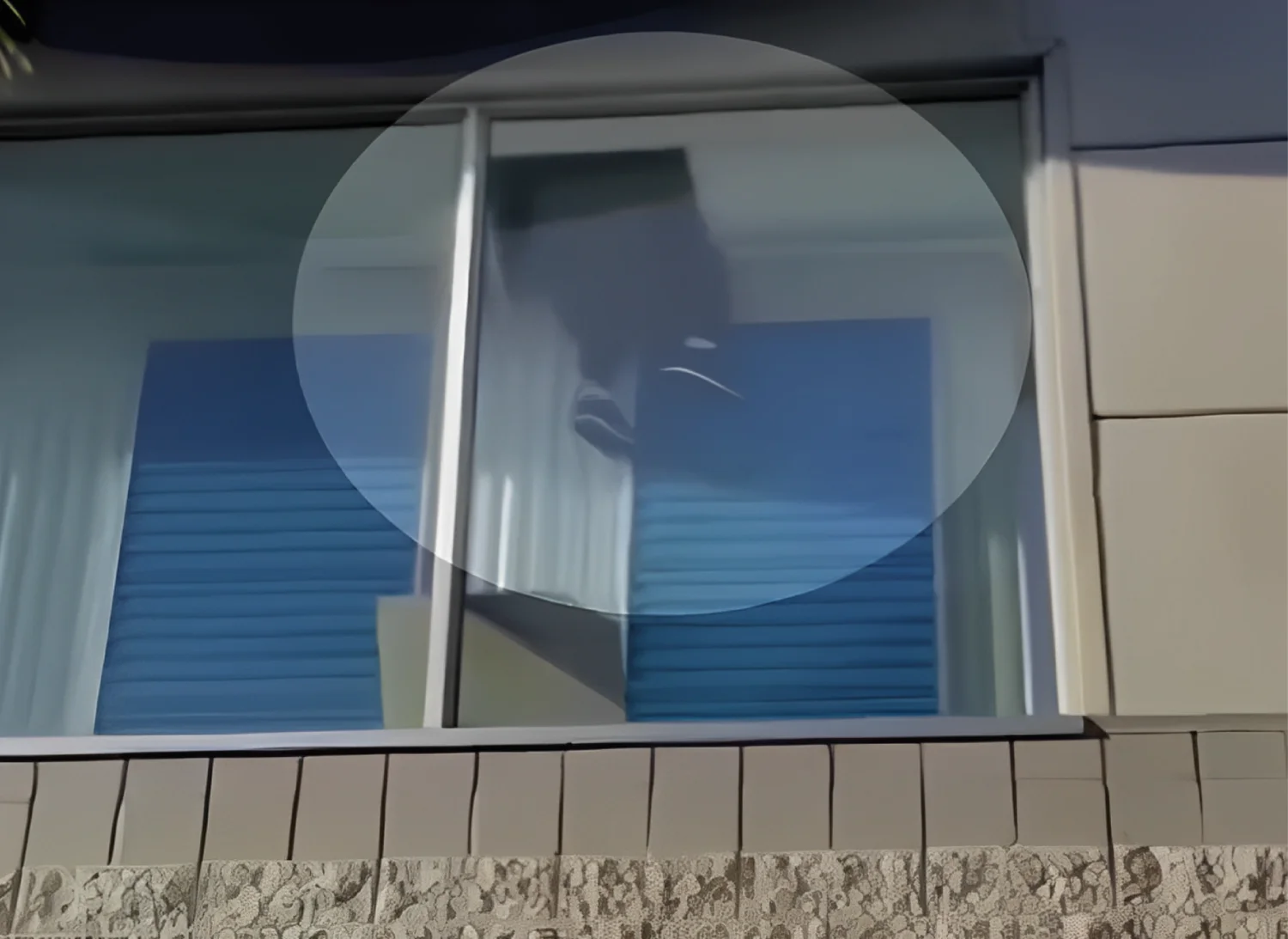
One security company that is working on a way to facilitate this type of collaboration between self-storage operators is OpenTech Alliance, Inc. Along with Xercor Insurance Services, it has created the Self-Storage Security Council. Robert Chiti, CEO of OpenTech, says the council has a mantra: “Criminals are becoming organized; it’s time for the self-storage community to do the same.”
Chiti says it’s imperative that self-storage operators share data, work together, and document theft in order to provide law enforcement with the information they need to do their job.
“Most self-storage operators deal with theft independently,” explains Chiti. “They don’t want to talk about it, because they don’t want it to become a public relations issue. But when a self-storage industry is broken into, especially multiple units impacting numerous tenants, it’s going to make the news anyhow. So we aim to create a format for collaboration.”
To be part of the council, operators must sign confidentiality agreements, stating that they will not use information to portray any other facility in a negative light. “We strive to create an environment where there is conversation without fear,” says Chiti. “We want to know what operators are doing about theft, what they’re seeing out there. Is there vandalism? A suspicious car? Tenants behaving oddly? Share that information. It could be valuable for others.”
The ultimate goal of the Self-Storage Security Council is to create a data tracking system. Since its inception, Chiti says four more insurance companies have joined, and there is now a network of more than 100 operators across the country sharing information. “We are organizing as an industry to protect ourselves and our tenants. With all of our data, we are starting to see patterns. We’re able to collect evidence to give to the police. And they’re able to turn what might be a misdemeanor into a felony and put these criminals away for a while. It’s about being proactive, not reactive.”
Chiti says the concept is still incubating, as the network works on structure, processes, and attracting new members. At that point, he says the plan is to go to the national Self Storage Association so build a bigger, more robust platform. “It doesn’t matter which security platform a facility has, which insurance company they work with,” Chiti says. “This is not about selling a product. This is about protecting the industry.”
If you are interested in being part of the Self-Storage Security Council, contact Kristie Adams at KAdams@OpenTech.com.
Unfortunately, many other self-storage operators didn’t step up to support their tenants, says Pierce. “I’ve never seen a group of individuals out for blood like I did yesterday, but of the many that were there fighting for justice, only one person was there on behalf of their company and their tenants. The rest were tenants from other facilities representing themselves alone and bearing the majority of the $500,000 in losses.”
“You have to advocate for the police to take these break-ins seriously,” says Eric Isaacson, a real estate investor with a focus on self-storage. He recalls the time one of his investments had a break-in and it was all on camera. “We saw where the burglar touched the wall, and we demanded that [the police] fingerprint that area. It turned up a print and they caught the guy.”
Isaacson says the crook then confessed to 12 other break-ins. “I went to the grand jury and said we have to set an example that we take this seriously. Our tenants loved our bulldog approach and felt cared about.”
Pierce understands the frustration. “We had one detective that wouldn’t answer calls, but another that was on it 100 percent,” he says. “So there’s the side of doing our due diligence, then the side of really pushing law enforcement to move forward.”
Tushim agrees. “The best solution to these types of events is being able to provide as much information as possible to the authorities, as soon as possible, to help them create a case. This means fingerprints, quality photos or video of the perp, a description of the vehicle and its license plate. Much of this information can be easily provided by using the existing security infrastructure in a facility, or by adding a few additional elements.”
“Ultimately, there needs to be accountability in this business,” continues Tushim. “If someone is paying you to store their stuff, it’s up to the facility to keep it safe. That means keeping up maintenance, for example. If your gate is broken and you’re not bothering to fix it, but you’re not discounting my rate for this sudden safety issue, that’s not right. The more seriously you take security, the more you can charge. Don’t undermine your business by only thinking with your pocketbook. This is how some self-storage owners fail themselves.”
Finally, when a case does go to court, Pierce firmly believes it’s important that owners show up for their tenants. “I’ve met good people in the courtroom that lost everything they had to their name with no backing from their facility,” he says. “As individuals, and as an industry, we need to be there for our tenants.”
he results are in! As those of you who took our recent reader survey know (thank you for participating), MSM did things a little differently this year. Along with asking questions about our publications to help us continuously improve and write about the topics that matter to you, we asked some questions about the state of the industry, challenges and opportunities on the horizon, and more. It’s our pleasure to present to you a summation of what your colleagues in the self-storage universe had to say.



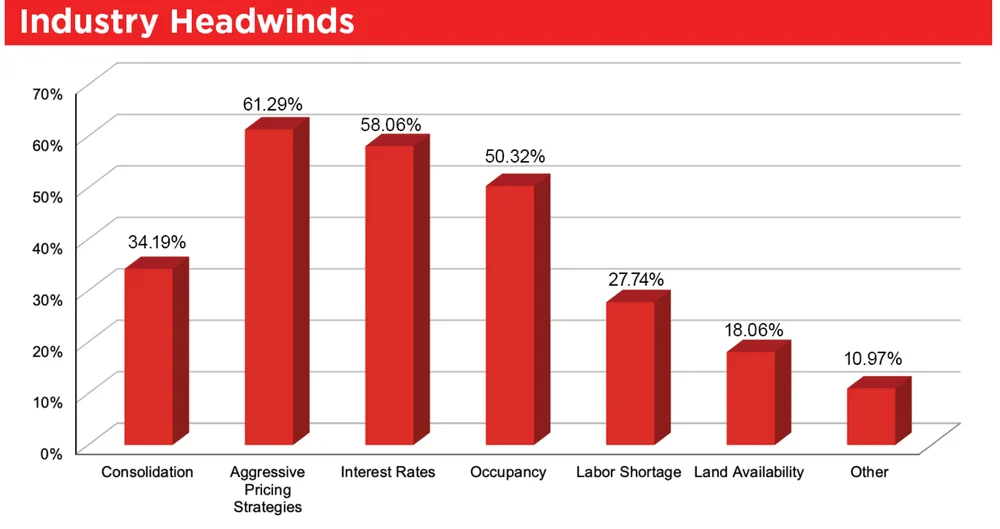
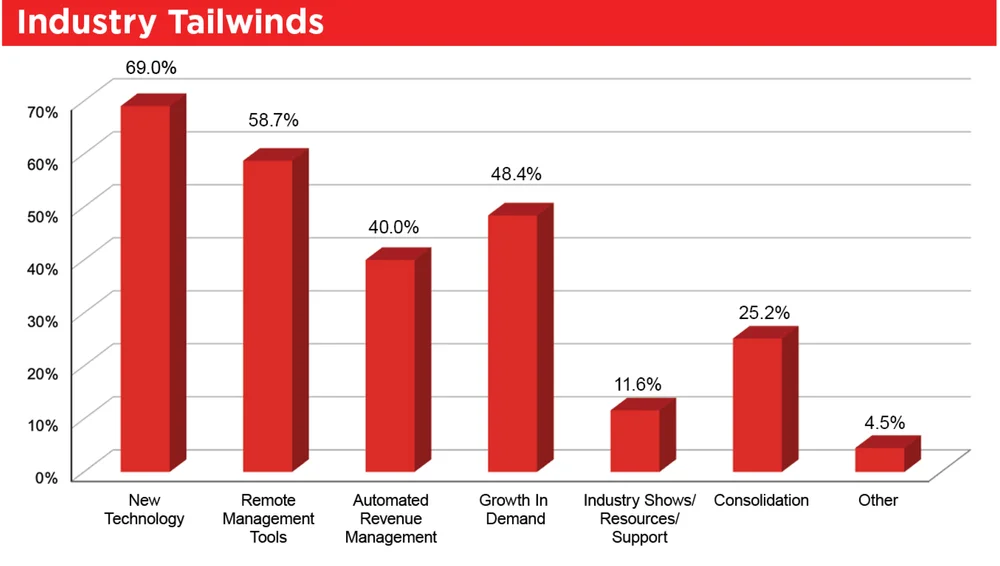
AI, a concern for a handful of respondents in the previous question, was mentioned as a plus here: “AI acceptance is growing,” wrote one respondent.
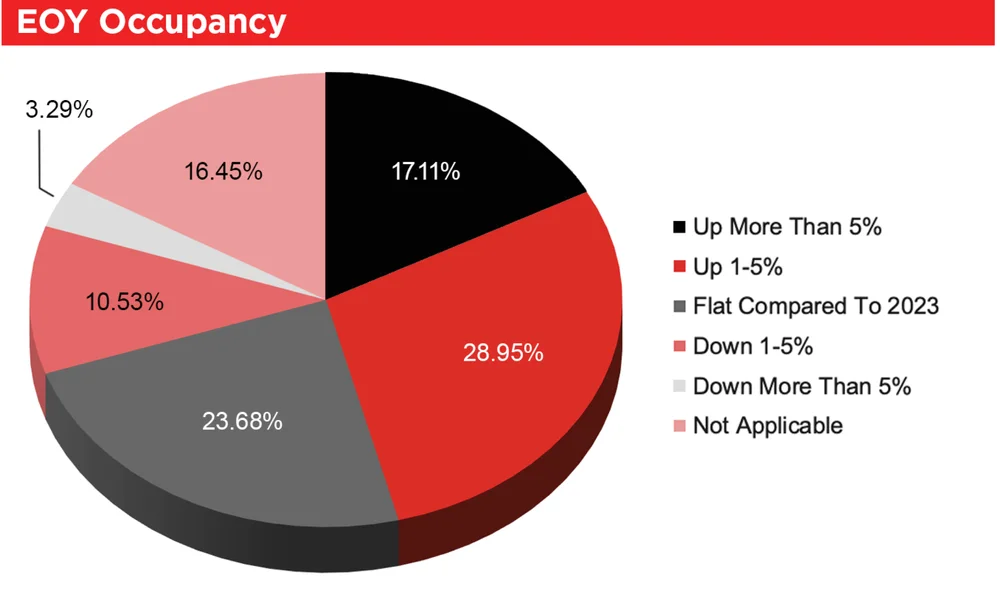
Online rentals and gate access are virtually tied at just over 60 percent each when it comes to the areas of the business that are automated. However, online auctions, revenue management, and door access are not far behind.

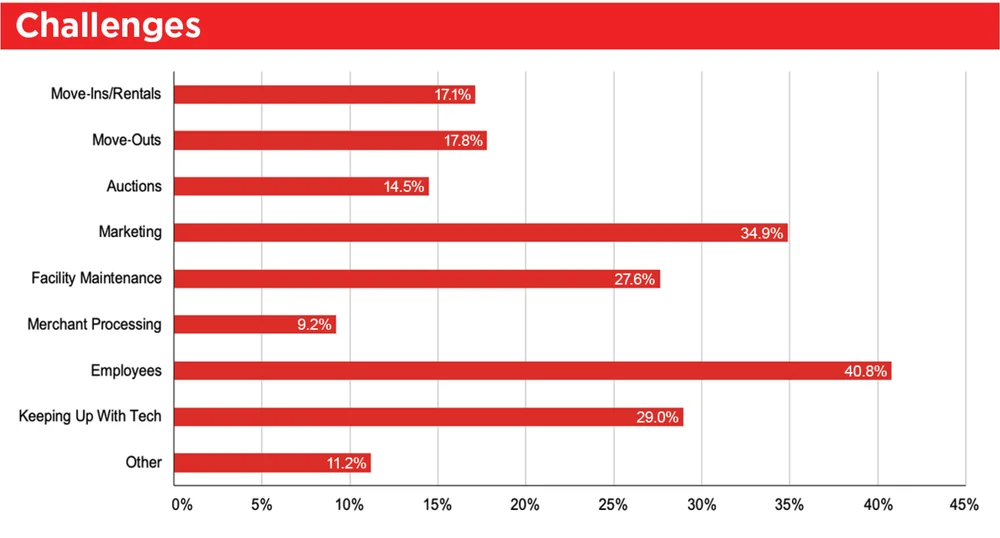
When it comes to marketing, one respondent followed up by saying that “SEO and PPC are very expensive to outsource and time-consuming and difficult to keep in house.”
Another respondent found managing tenants to be complicated due to the storing of illegal or unallowed items and demands for refunds. “Unfortunately, customers are going to try to store what they want to and not what is acceptable. Also, if one company offers refunds for unused days, customers think every company is supposed to do that even when the lease states differently,” wrote the respondent.
Finally, one vendor is weary of “unsophisticated clients,” possibly hinting that some operators are not keeping up with technology, as 29 percent of respondents admitted it was a challenge.

“If you could choose to automatically and anonymously share your data with a secure repository via your property management software to improve the overall industry dataset in exchange for reporting on your market, would you?”

- It’s not safe; I don’t want to lose my competitive edge.
- I’d love to see it, but I cannot get unanimous partner consent.
- I don’t trust any entity to be impartial.
- Too many people will have access to it.
- My detail and innovation are my edge, and I don’t want to lose it.
- I’m happy to share information but not via automation due to personal data exposure.
- There have been too many data breaches out there.
- It’s too risky to potentially expose our data.
- Privacy … It is privileged information.
- I would want to know who I’m sharing with.
One respondent stated that they don’t use property management software, while another simply wrote, “I don’t want to share.”
We’re not looking to solve the industry’s problems—yet! For now, we’re just presenting the results of our reader survey. However, we’re listening, and we’ll be following up with the stories you want to read and the questions you want answered. Thank you for reading!

We appreciate all your suggestions on how we can make our publications better, and for sharing the topics you’d like to see more coverage on. You can expect to see stories on them in future online and print stories.
Of course, we also enjoy reading all the words of encouragement:
- “I love your magazine just the way it is!”
- “In the past year, your coverage has expanded wonderfully!”
- “Your topics are more in-depth than other industry publications.”
- “Keep doing what you’re doing!”
- “You’re doing a great job!”
On behalf of all of us at MSM, thank you for your readership and support, and we hope you enjoyed your $5 gift card. Just for fun, here’s one last chart on the card redemptions. Our readers clearly love Amazon and Starbucks!
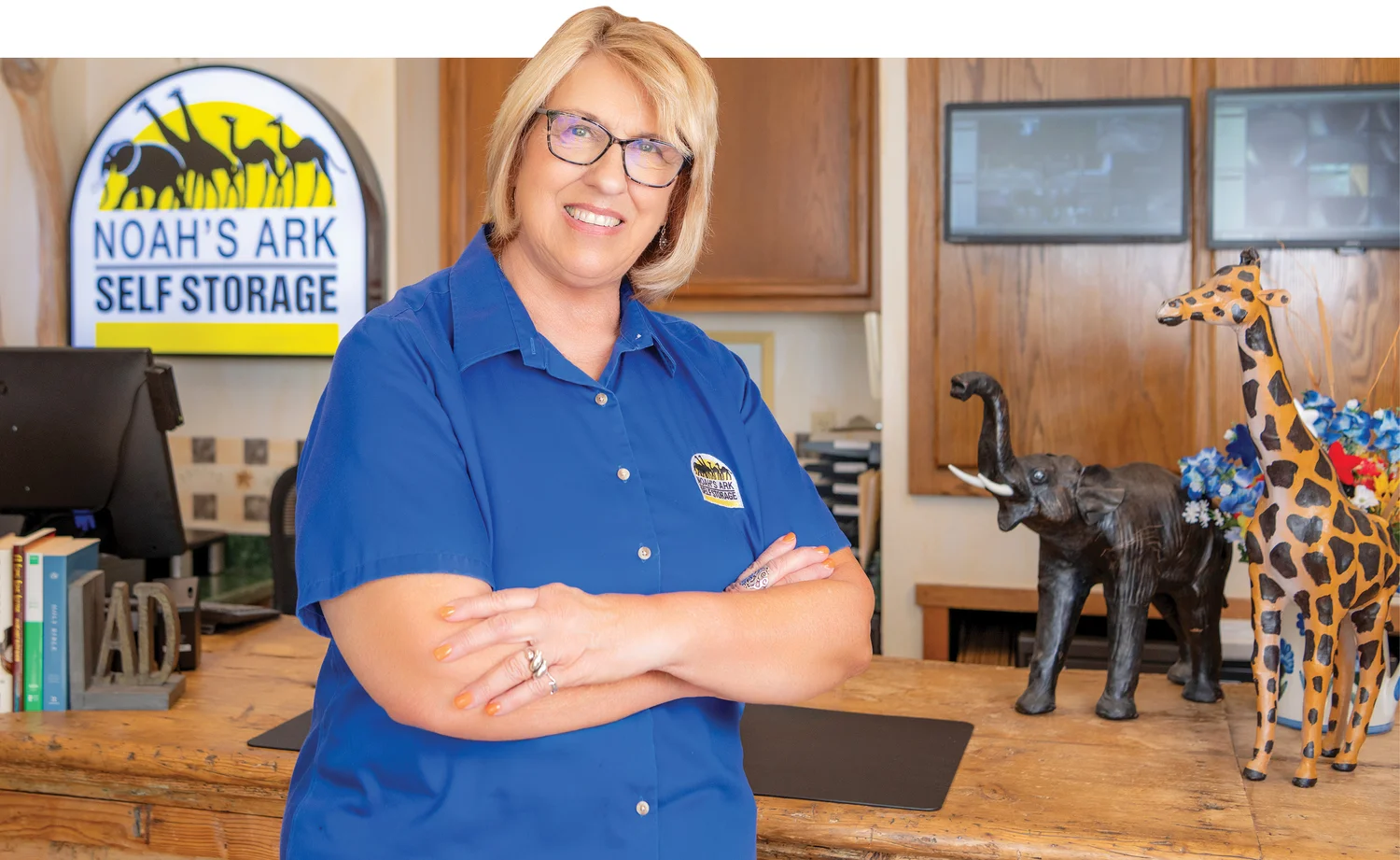
uring the days of disco, Ann Parham, CEO of The Parham Groups, was a student at Stephen F. Austin State University in Nacogdoches, Texas. The times were changing, and new opportunities were becoming available to females throughout the United States. So, when the educational institution’s Army Reserve Officers’ Training Corps (ROTC) permitted women to join, Ann, whose father was in the military and who calls herself a “natural boss,” was first to enroll. She went on to become the program’s first female commissioned second lieutenant.
That’s also where she first met her husband Michael “Mike” Parham. They hit it off and started dating. It wasn’t long before they were married. The year was 1976; Ann, a junior in college, was 20 years young. Although they found themselves at the altar slightly sooner than anticipated, they wed in order to be stationed together upon completion of the ROTC program. Unwilling to be separated, that hurried union turned into 39 years of marriage.
“Mike was Mr. Personality and the All-American Boy Scout,” says Ann. “I knew he was going places and had a future ahead of him. He was also lots of fun and crazy about me! That is very hard to resist!”
After graduation, Ann was stationed close to Indianapolis, Ind., at Fort Benjamin Harrison, where she completed her officer basic course for three months. Mike attended engineering school at Ft. Belvoir in Virginia, which was a six-month course. Ann was delving deeper into her leadership and management training, focusing primarily on personnel management and club management. There she further developed the skills necessary to eventually lead offices and companies.
Their careers began to shift in different directions after they returned to their home state of Texas. They were both stationed at Fort Hood (now known as Fort Cavazos) in Killeen, where Ann worked at III Corps, the office that was responsible for starting the military’s first personnel database, and Mike was assigned to 62nd Engineer Battalion. Processing data within that database to produce meaningful information became her newest proficiency—an aptitude that set her up for a career outside the Army. Then they made the decision to leave military life and pursue a civilian career.
About being one of the only females in the officer rank from the late 70s to mid-80s, Ann says she made it a point to “do a better job than anyone else” to earn the respect and acceptance of her male counterparts, essentially “winning them over with performance.”
Subsequent to acquiring a wealth of knowledge about leadership, management, and data processing, Ann joined Affiliated Computer Systems (ACS) in Dallas, Texas, the company that started the automatic teller machine (ATM). She was working third shift at the company’s downtown location in data processing management, the production shift that ensured the ATM withdraws were processed. “It wasn’t live,” Ann says about the reporting of account holders’ available balances, “so there were lots of overdrafts.”

Over the next few years, the Parhams continued to expand their company and their family. While on maternity leave with their second daughter, Rebecca, Ann temporarily stepped into an office management role for NDS. As she handled administrative tasks and odd jobs, she was simultaneously learning the ins and outs of the construction business. However, when interest rates skyrocketed, Ann returned to the bank as the production control manager.
Then, in 1993, with two daughters and one company under their belts, the Parhams grew again, adding their son David and Noah’s Ark Development to their lives. Because the department she was managing dissolved, and Mike’s administrative assistant left, Ann took on a permanent position within the family business.
Four years later, Mike built the family’s first self-storage facility with future phases already in mind. It was a single-story, climate-controlled building and non-climate buildings on a hill in Bulverde, Texas. Ann thought he was “crazy” at the time, but she served as its first property manager.
“It was a baptism by fire,” Ann says, acknowledging that she knew nothing about self-storage management at the time. Nevertheless, her life experiences as a second lieutenant, production control manager, wife, and mother enabled her to take on the position with extraordinary acumen. In fact, she did such a remarkable job that the Parhams founded Joshua Management in 1997 to manage the Noah’s Ark facilities they were developing. As president, Ann led it to great heights, securing placement on Messenger’s annual Top Operators list numerous times. At its largest, Joshua Management was managing 15 facilities throughout Florida and Texas.
“I’ve done every job except superintendent,” says Ann. “I can relate to managers because I’ve been in their shoes. It’s not as easy of a job as owners may think.”
Moreover, Ann’s military background didn’t persuade her to utilize the stereotypical authoritarian leadership style often associated with drill sergeants. Instead of being inflexible and domineering, she created a collaborative environment that enables managers to thrive.
About the company’s managers, “Their input is invaluable,” Ann says, adding that she experiences no turnover because she treats her managers like family members, business partners, and an important part of the team—an approach she attributes to her Army training. It’s important to “take care of the troops,” she says. “Find a great manager and treat them like they’re golden.”
It’s proven to be effective, as Ann points out that one employee has been with the company for 29 years. “They don’t leave! We provide what they need to succeed.”
What’s more, Joshua Management’s managers are trusted to problem-solve and think on their feet rather than adhere to canned, impersonal scripts. “Not all responses can be typed,” says Ann. “Every store is different. You can’t manage them all the exact same—managers or stores.” For that reason, the company’s team members serve as “test customers” for managers in training to enable them to learn how to handle various situations that may arise on the job. Property managers are selected to fit the market on hand, and the way in which they manage sites is based on the demographics. According to Ann, operating every property the exact same way, regardless of the city and its people, “doesn’t fly.”
Her successful management methods resulted in her becoming a trusted and respected professional within the self-storage industry. As such, Ann was frequently called upon to lead round table discussions, author educational articles, supply advice for various management-related articles, and speak at conferences for the Arizona Self-Storage Association, Texas Self Storage Association, and Louisiana Self Storage Association. Additionally, The Parham Group has won five of Messenger’s prestigious Facility of the Year awards (1991, 1994, and 1996 as well as the Construction Facility of the Year award in 2014 and the Overall Facility of the Year in 2015).
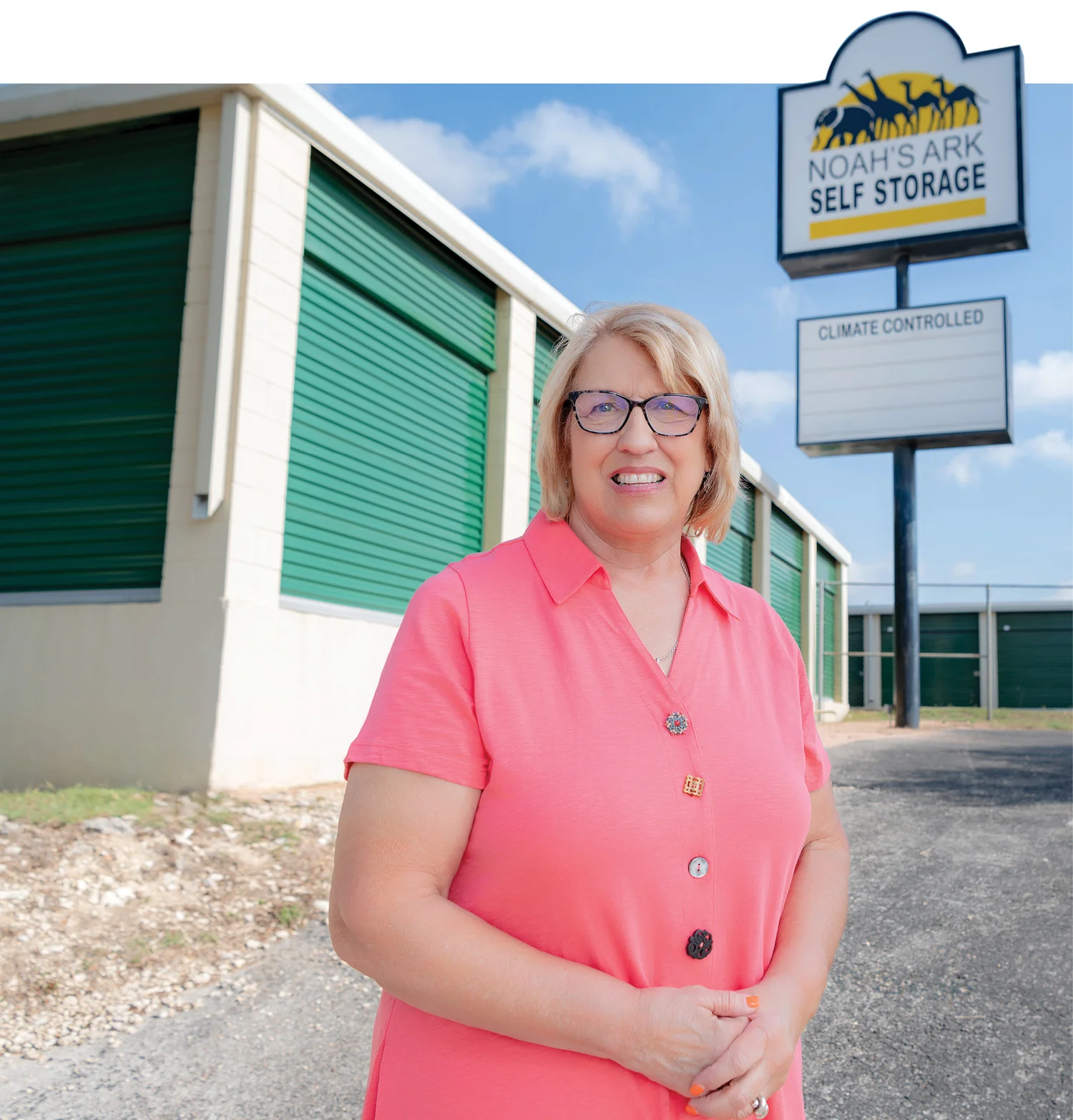

“We called clients to tell them we’d be carrying on,” recalls Ann. “Having to pick up everything and losing him was the greatest challenge of my life, but I knew staying in bed wouldn’t help.” They didn’t have set succession plans in place per se, but they knew at least Rachel would carry on the business; she had been working alongside Mike for several years before his death. Ann adds that being prepared for the inevitable is advantageous. “The best gift to give your family is having everything in place.”
As the matriarch, Ann became CEO and president of the Parham Group, while Rachel stepped into the role of president at Noah’s Ark Development and NDS Construction and David joined the business to assume the role of president of Joshua Management. Together, the family maintains the same core values and principles on which Mike founded the companies.
Since that shift in leadership, Ann, who is beyond proud of her three successful children, has been trying to take more of a backseat in the business. “I’m allowing them to take over some,” she says, which can be difficult for a woman who’s used to being in charge. “I’m working in more of an advisory capacity now and training others to go to David and Rachel for answers instead of me.”
Giving Rachel and David more leadership leeway has provided Ann with more time to pursue other interests. She’s currently more involved with her own community, serving on the boards of nonprofits and the local chamber of commerce.
And while Ann may make time to travel, she isn’t likely to walk away from The Parham Group entirely. “I will probably always have a foot in the door,” she says, “but I’m no longer the future of this company—Rachel and David are.”


t Boardwalk Storage on Central Avenue in LaFollette, Tenn., Amy Hooks stands out as a dedicated property manager. She goes above and beyond to cater to her beloved community while also fostering growth within Boardwalk Storage.
Hooks has been the property manager of this Boardwalk storage facility for two years; she handles a myriad of responsibilities, and she does it with grace and poise. She mentions that she is “handling payments, the daily care and maintenance of the facility, flipping the units when guests move out, things like that.”
Being hands on is something Hooks highly values in her work. “The manual labor side of the job is great. I feel like it’s just a good fit for me, regarding my experience,” she says, adding that she handles “all the phone calls, inquiries, answering leads that are submitted online about guests interested in units, providing quotes, and helping them find a unit that fits their needs.” When it comes to managing this facility, Hooks attends to even the most meticulous of details to make sure things are running smoothly and customers are always taken care of.
While LaFollette is a small, remote town in Tennessee, Morris Lake is a popular vacation attraction. Growing up in LaFollette provided Hooks with an intimate knowledge of the town, its community, and the socio-economic function of the town itself. This gives her an edge in the vacation rental space as well as the self-storage landscape. After all, storage facilities and vacation rentals are cut from the same cloth: They both provide essential space to customers.
Something she brought to Boardwalk Storage’s attention was the high occupancy rates at marinas and how difficult it is to secure a boat slip for the summer. Hooks also noted that their facility is about 10 miles away from all the local marinas, which many tourists and annual vacation dwellers have difficulty booking due to a lack of availability and an inability for marinas to expand due to the layout of the town.
Seeing an opportunity, she utilized their facility as summer storage for trailers, boats, campers, and more. Rather than requiring monthly rentals, Hooks implemented a weekly rental opportunity, as many visitors only require a storage unit for a week or so while on vacation. All the local marinas have about a year waitlist, and this Boardwalk facility happens to be close to the highway, according to Hooks, which is a boon for the business.
“We have a lot of open space with the possibility to build even more big units to accommodate people,” she says. “I want them to be able to expand and just grow the property in general.”
She seized the opportunity to advertise to the local demographic, a very strategic move that greatly benefits all parties involved. Hooks goes on to say, “Boardwalk wanted to stay in LaFollette; we wanted to build a rapport with the community. I’ve been able to grow the facility to about 89 percent occupancy, and I am working towards getting it to 100 percent occupancy.”


Along with the day-to-day tasks, Hooks is responsible for the facility’s social media. In fact, her content had such high engagement on platforms like Yelp, Google business, and Facebook that Boardwalk Storage asked her to teach other property managers her social media techniques. Specifically, Hooks has grown their facility’s Facebook page tremendously, gaining as many as thousands of engagements a month. This work is paramount to a business’ growth, and part of the reason why Boardwalk Storage hired Hooks in the first place. Her interactions with customers and overall charisma greatly contribute to her work as a facility manager; she not only sustains the wellbeing of the facility but takes the extra step to promote, advertise, and uplift the facility.
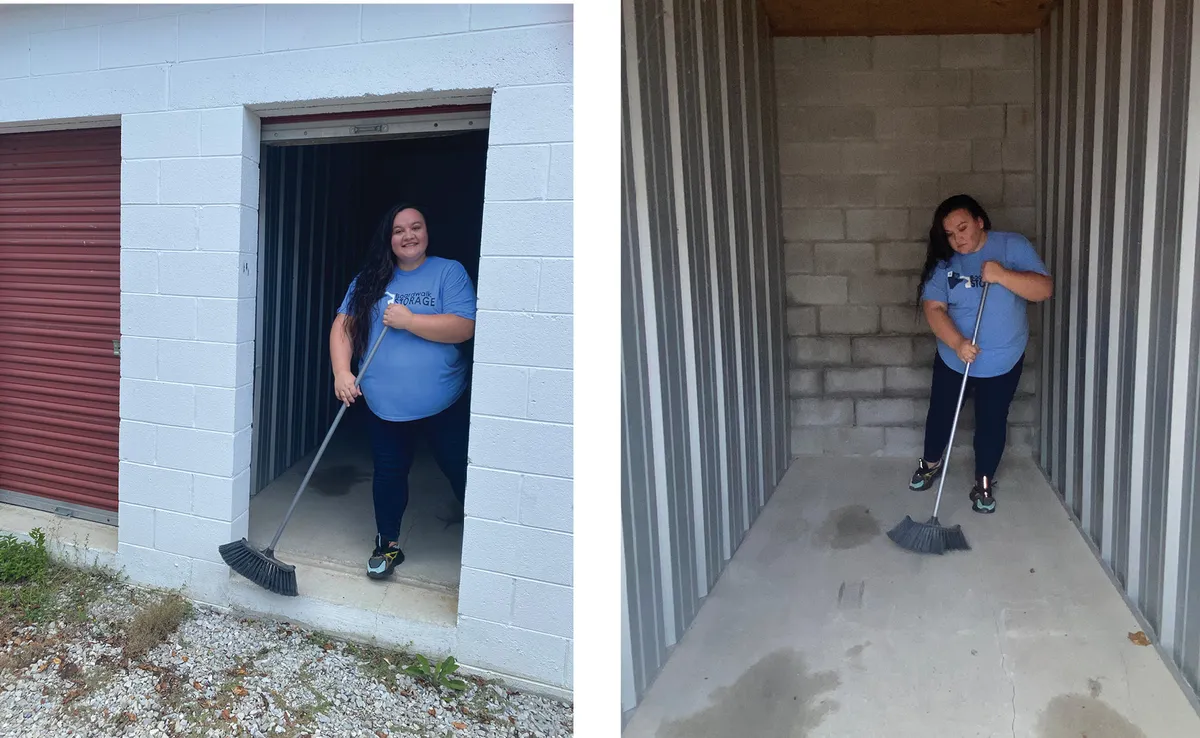

Her empathy provides a bridge between the transaction and the customers. She mentions how gratifying it is to provide some sense of relief for those who are enduring a difficult time. “That touches me,” says Hooks, “That something like self-storage helps me take something off their shoulders or off of their plate. That’s so rewarding.”



ach of our businesses tells a story. You may think your story is simply, “I have 10-by-10 climate-controlled units now available,” but there’s actually a lot more to it. Your story could be about cleanliness and convenience through well-placed technology and a well-kept property. Perhaps it’s a story of hospitality through homemade cookies in an office and a friendly property manager. Or maybe your story goes further, showing community involvement through sports sponsorships, toy drives, or charitable donations. Stories connect us with the people with whom we interact, and shaping that story can go a long way toward building goodwill with current and potential customers.
As you think about your business, what story are you telling? Is it all about self-storage, or does it go deeper? As many owners are finding out these days, customers want to know more about the heart behind a business. They are curious about where you might stand on cultural and social issues. Eighty-three percent of consumers wish more of their retailers would support the causes they care about, and many retailers are taking advantage of this trend by being more vocal about the causes that mean a lot to them. This focus on cause marketing is growing in virtually every industry, including self-storage.
So, where do you start? How do you tell your customers what you really care about? How can you avoid divisive causes that could cost you business while supporting those that can really make an impact, not just for your company but for those who benefit from the causes you support?
A simple place to start is to ask these two simple questions: What is important to you and what is important to your community? Hopefully they line up. For many of the more mainstream causes, you won’t get any pushback. Things like supporting the local high school, helping the homeless, supporting veterans, and fighting cancer are hard to argue against. The trickier part is putting the right things in place to enable your customers to see your involvement and get involved themselves. That’s where an organization like StorageGives comes into play.

Today, StorageGives provides a wonderful and effective conduit for self-storage owners to connect to their customers by highlighting causes that are important to them, thereby telling more of their story. You can find out more about the causes supported by StorageGives at StorageGives.org/causes. These causes focus on four main areas: water, children, medicine, and veterans. I think we can all agree that each of these categories deserve our attention and resonate with most people.

A recent addition to the list of causes is the Sparrow Foundation, based in Louisiana, which fights human trafficking. At the SSALA Fall Conference in Baton Rouge last year, $40,000 was raised after a moving address from its founder.
“Our attendees were moved to tears after hearing first-hand accounts of trafficking, abuse, and how Sparrow Foundation was making a difference,” commented Melissa Huff, director of the Louisiana and Tennessee Self Storage Associations. “It was so eye-opening that I decided to bring them back again for our next conference to educate us on how to spot trafficking that may be happening at our facilities and how to get involved.”

Customers today are looking for more than just a place to store their belongings—they are looking for businesses that reflect their values and contribute positively to society. By embracing cause marketing and getting involved with StorageGives, self-storage owners can elevate their business from merely a service provider to an active part of the community that helps their customers contribute in that positive way. If you aren’t telling this part of your story, it’s time to get involved, whether you donate a portion of your auction proceeds, sponsor an event, or enable your customers to donate directly.
As Huff’s testimonial highlights, the emotional and social impact of these efforts can be profound, leading to greater awareness and engagement within your community. When you tell your story through the support of veterans, the fight against human trafficking, the advancement of medical research, or the provision of clean water, you are telling a story that customers want to hear and be a part of.
So, start today by exploring the opportunities StorageGives offers. Visit StorageGives.org to learn more about the causes you can support and find inspiration in the stories of others who have made a significant difference. Together, we can transform our industry and our communities, one charitable act at a time.
owadays, it’s not uncommon for a self-storage facility to offer parking spaces for outdoor vehicle storage. But occasionally people make their own unofficial parking spot, causing plenty of damage in the process. Here’s a handful of unfortunate instances.
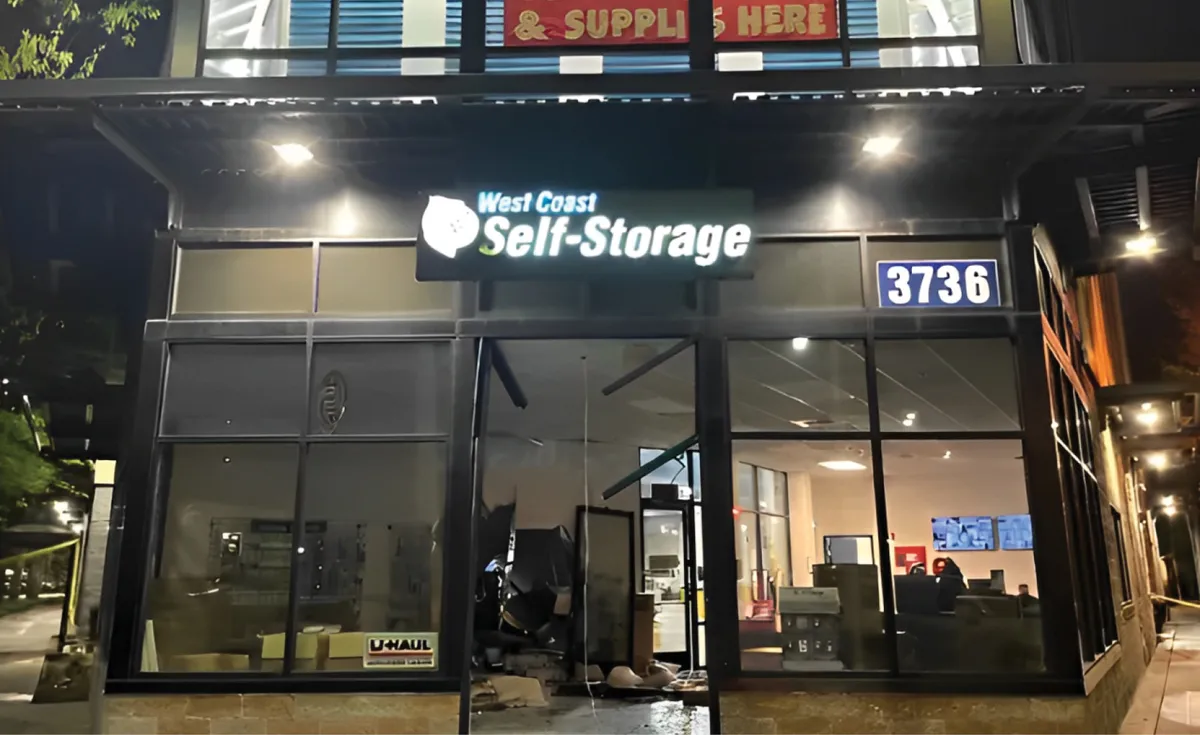

Although the driver said the truck hydroplaned due to wet conditions, the facility’s co-owner wasn’t convinced that was the cause. “There was very little if any rain since we haven’t had any, so we aren’t the only ones who feel that story isn’t quite true,” Debi Peterson, co-owner of Steve’s Self-Storage, wrote in an email to the Gila Herald. She stated that the truck also took out a brick wall, a pine tree, and two fences. “I can tell you though, that these diesel trucks, motorcycles, and many, many cars use this part of the highway as a speedway and racetrack all hours of the day and night. Rarely are they pulled over! Either way, he is guilty of reckless driving and is responsible for all the items that are lost. It would be nice if he could apologize at least to the woman who lost everything in her two storerooms and the man who lost everything in his. Not to mention the other storerooms with smoke-damaged items.”
-
Incode Partners With TenantIncode, a provider of online identity verification solutions that were developed by leveraging advanced AI and machine learning technologies, has partnered with Tenant, Inc., to enhance its tenant onboarding process. The partnership will support Tenant, Inc. when it comes to securing tenant information, ensuring compliance, protecting against fraud, simplifying KYC (know your customer) processes, reducing paperwork, speeding up verifications, reducing onboarding times, boosting efficiency, and enhancing user experiences.
-
Storable Releases Tenant Insights ReportStorable has released its new “Tenant Insights Report 2024,” highlighting the various complexities facing operators today as multiple headwinds impact the industry’s outlook. More than 1,000 tenants in the U.S. were surveyed for the report. Designed to help operators and their teams better understand the ever-changing self-storage landscape, its results offer insights into storage demand, technology’s role in management, and the shifting expectations of customers. To download the report, visit https://info.storable.com/tenant-insights-report.
-
Customs Seize Drugs From Storage
 A 19-year-old male was recently arrested after customs seized about 4.4 kilograms of suspected crack cocaine and about 600 grams of suspected synthetic cathinone (also known as “zombie drug” bath salts) in Sai Wan, Hong Kong. Customs seized the batch of drugs, which were worth an estimated HK$6 million, approximately $768,055.45 (USD), from a mini-storage locker in a Sai Wan industrial building during an anti-narcotics operation. The 19-year-old arrested was said to be the lessee of the mini-storage locker.
A 19-year-old male was recently arrested after customs seized about 4.4 kilograms of suspected crack cocaine and about 600 grams of suspected synthetic cathinone (also known as “zombie drug” bath salts) in Sai Wan, Hong Kong. Customs seized the batch of drugs, which were worth an estimated HK$6 million, approximately $768,055.45 (USD), from a mini-storage locker in a Sai Wan industrial building during an anti-narcotics operation. The 19-year-old arrested was said to be the lessee of the mini-storage locker. -
Store House Raises Funds For RescueThe Store House Kong, a subsidiary of General Storage Company, which operates a network of self-storage facilities in Singapore and Malaysia under the Lock+Store brand name, is holding a fundraiser to benefit Hong Kong Dog Rescue (HKDR). In addition to raising awareness about pets and pet care, the fundraiser will be selling limited-edition dog keychain bags for HK$100 each. They can be purchased from the company’s western district mini storage facility in Sai Wan or at HKDR shelters across the city. Proceeds of each bag will be donated to the HKDR, helping the organization provide food, shelter, and medical care for dogs.
-
SteelBlue Unveils New DoorSteelBlue Building Components LLC, a manufacturer of self-storage roll-up doors and hallway systems, has added a new product to its inventory. Designed for easy installation and operation, SteelBlue’s new 9530 Series roll-up door has panels that are seamed together. Its noteworthy features include a shorter door guide, wear strips, symmetrical headstop, round drum, and a tensioning device that requires no special tools. The 9530 Series roll-up door comes in 26-gauge, grade-80, and pre-painted steel in a variety of colors.
-
SSA Announces Law AmendmentsThis spring, the Self Storage Association (SSA) announced new self-storage law amendments in two states: Kansas House Bill 2545 was signed into law by Gov. Laura Kelly and Georgia House Bill 934 signed into law by Gov. Brian Kemp. Both HB 2545 and HB 934 took effect on July 1, 2024, and set forth a process for disposing of property remaining in a unit after the end of the rental agreement. According to the SSA, the language in HB 2545 and HB 934 primarily deals with tenants whose agreements were terminated or not renewed for a reason other than non-payment and who left property in their unit. Both bills recognize that agreements may be delivered and signed electronically and establish a process regarding the enforceability of unsigned rental agreements.
-
Vantiva Launches Management PlatformGlobal connectivity technology company Vantiva has launched its Vantiva Smart Storage™ Version 1.0 operations management platform, which is compatible with new and existing devices and subsystems and designed to improve self-storage portfolio efficiencies by unifying its technology systems onto one dashboard. This allows operators to monitor all their locations at once, with data insights, such as identifying inefficiencies, at the site, regional, and portfolio level. Vantiva Smart Storage V1.0 enables site operators to reduce utility costs through remote HVAC monitoring and control, automate time-consuming daily tasks like lock-checks and walk-throughs, respond to real-time alerts addressing events that could damage the facility, increase safety and security through intrusion detection and motion-based video capture, and simplify and improve employee experiences through unified subsystem management. To learn more, visit www.vantiva.com.
-
Janus Acquires TMCJanus International Group, Inc. has acquired Terminal Maintenance and Construction (TMC), a premier provider of terminal maintenance services for the trucking industry in the Southeast. Headquartered in Madison, Ga., TMC’s offerings include trucking terminal renovation, remodeling, and maintenance services. While initially continuing to focus on commercial customers, TMC’s integration will ultimately help support the growth of Janus’s Facilitate division, which offers complete facility maintenance services.
-
Andover Starts Lending ProgramAndover Properties, which operates more than 13.5 million rentable square feet across 162 facilities in 18 states under the Storage King USA brand, has launched Andover Storage Lending, a program that was developed to originate non-recourse financing for self-storage sponsors nationally. It’s designed to provide bridge and construction financing for up to 90 percent of value without requiring third-party management or bank deposits. The program’s first loan origination went to Madison Capital/Go Store It to refinance a Class-A facility in Richmond, Va. Andover reports that several other loans in negotiation are expected to close in Q2 and is actively quoting bridge and construction loans for storage facilities across the U.S.
-
Pogoda Expands PortfolioMichigan-based Pogoda Companies, a provider of self-storage management services, recently added two new management contracts to its portfolio, increasing its size to 72 self-storage properties throughout Michigan, Ohio, Kentucky, and Indiana. National Storage–New Center in Detroit has 19,200 square feet of climate-controlled space in 189 units, with room to expand; this prime location is housed within the bottom two floors of the historical Albert Kahn building, previously occupied by Saks Fifth. National Storage–Woodman in Dayton has 68,200 square feet in 677 units and is a mixture of drive-up spaces, climate-controlled units, and RV and boat storage; it is expected that 15,000 square feet of drive-up storage will be added by late fall. Each location has 24-hour digital surveillance and will offer a full line of boxes and packing supplies. Both facilities have been rebranded under Pogoda’s National Storage flag and added to its website.
-
Iron Storage Launches SoftwareIron Storage, a privately owned self-storage company with facilities across six states, has launched its new management software, enabling the company to remotely manage its facilities. The software is designed to streamline facility management, ensuring that Iron Storage can maintain its high standards of cleanliness, security, and customer service across all locations. A press release further states that the platform will enhance operational effectiveness, benefitting customers through improved service quality.
-
MSM Releases New Handbook
 MSM, the company behind Messenger magazine, the industry’s longest-running publication, has released the 2024 edition of its RV and Boat Development Handbook. At 112 pages, it’s the largest publication dedicated to this real estate sector. The handbook offers a wealth of information about developing RV and boat storage and uses the most current information and data available, gathered from experts in the industry who have extensive experience developing these specialty storage facilities. Purchase a print, digital, or combo copy of the 2024 RV and Boat Development Handbook at www.modernstoragemedia.com.
MSM, the company behind Messenger magazine, the industry’s longest-running publication, has released the 2024 edition of its RV and Boat Development Handbook. At 112 pages, it’s the largest publication dedicated to this real estate sector. The handbook offers a wealth of information about developing RV and boat storage and uses the most current information and data available, gathered from experts in the industry who have extensive experience developing these specialty storage facilities. Purchase a print, digital, or combo copy of the 2024 RV and Boat Development Handbook at www.modernstoragemedia.com. -
Company Redefines Remote ManagementWhite Label Storage, a premier third-party management company specializing in remote self-storage management nationwide, is redefining the industry standard with its innovative approach. Co-founded by Alex Harman and Peter Smyth, the company now has a portfolio of over 90 facilities under management, leveraging years of experience to help self-storage owners maximize profitability while managing the complexities of day-to-day operations. White Label Storage provides a comprehensive suite of services, including customer support and call center services, revenue management and maximization, expense analysis and reduction, property maintenance coordination, expert marketing, delinquency and auction management, bookkeeping and comprehensive reporting, and technology assessment and improvement. Visit www.whitelabelstorage.com for additional details.
-
KISS Offers New Lock
 After successful pilot programs in Q4 of 2023 and the first significant sale in January of 2024, Keep It Simple Storage (KISS) has announced the launch of its NFC OneLock, which offers unique convenience and security features, such as battery-free operation through near-field communication (NFC) technology, Bluetooth-free operation, and no hardwiring requirements. OneLock offers three different configurations and no hardwiring necessities, allowing operators to complete a rollout in less than half a day. KISS has integrated its NFC OneLock with a number of self-storage management software platforms, including Sitelink, StorEdge, and Space Manager. Plans for integration with SSM are underway, slated for completion by the end of the calendar year. For more information about the NFC OneLock, visit www.keepitsimplestorage.com.
After successful pilot programs in Q4 of 2023 and the first significant sale in January of 2024, Keep It Simple Storage (KISS) has announced the launch of its NFC OneLock, which offers unique convenience and security features, such as battery-free operation through near-field communication (NFC) technology, Bluetooth-free operation, and no hardwiring requirements. OneLock offers three different configurations and no hardwiring necessities, allowing operators to complete a rollout in less than half a day. KISS has integrated its NFC OneLock with a number of self-storage management software platforms, including Sitelink, StorEdge, and Space Manager. Plans for integration with SSM are underway, slated for completion by the end of the calendar year. For more information about the NFC OneLock, visit www.keepitsimplestorage.com. -
Storagely Integrates CalcumateStoragely, the self-storage website solution that guarantees an increase in rentals through its platform, has integrated Calcumate, a leading 3D storage calculator (size guide), directly into its technology. The Calcumate functionality is currently being rolled out to Storagely’s existing customers. With Calcumate, Storagely can allow prospective tenants to calculate and visualize the best storage options for their belongings. Additional details can be found at storagely.io/calcumate.
-
Storable Acquires StorageAuctions.comStorable recently acquired StorageAuctions.com, an online platform for self-storage auctions. By integrating StorageAuctions.com’s online auction services, Storable expects to improve upon its existing offerings by including an auction module that addresses clearing delinquent units. The acquisition was finalized on June 4, 2024. StorageAuctions.com will operate as a division of Storable. Current customers of both companies can expect seamless continuation of all existing services and support.
-
Storable Launches ITV TechnologyStorable has launched an Insured-To-Value (ITV) technology for the self-storage market, eliminating the longstanding challenge of ensuring tenants have adequate insurance coverage for their stored belongings. By dynamically adjusting minimum coverage requirements based on unit size, ITV protects tenants from being underinsured while unlocking a new revenue stream for operators through higher premiums. This new solution, widely used in property insurance but never before available in self-storage, offers a way to safeguard tenant assets and boost profits. For details, visit www.storable.com.
-
SafeLease Reputation Now AvailableSafeLease has launched SafeLease Reputation, a suite of tools to help self-storage facilities manage and protect their online reputation. SafeLease Reputation helps facilities collect, monitor, and display customer reviews online. This new enhancement furthers SafeLease’s mission to increase the value of self-storage assets by enabling operators of all sizes to bolster a strong online reputation that increases search engine visibility and improves occupancy. SafeLease Reputation is specifically built for storage facilities and leverages key tenant lifecycle moments to optimize the feedback-collection process while reducing store managers’ workload. To learn more about SafeLease Reputation, visit safelease.com/reputation-management.
-
Ching Named Woman Of Influence
 The Investment Real Estate Group of Companies (IREGC) recently announced that Mary Beth Ching, who has been with IREGC since 2021, was named a “2024 Woman of Influence” by the Central Penn Business Journal. The award is given annually to women based on their professional experience, community involvement, and commitment to mentoring. As chief of staff, Ching partners with leadership to maintain the company’s culture and core values. She also works with investors, vendors, financial institutions, partners, state boards, and member associations in the local community and nationwide. A board member of the Appell Center for the Performing Arts of York, Pa., she earned her bachelor’s degree from York College. Ching has been a longtime advocate in LGBTQ+ affairs and helped create “Pride Night for the York Revolution” and served on the board of “The Black and White Party” from 2007 to 2013, raising funds and support for HIV/AIDS-related organizations.
The Investment Real Estate Group of Companies (IREGC) recently announced that Mary Beth Ching, who has been with IREGC since 2021, was named a “2024 Woman of Influence” by the Central Penn Business Journal. The award is given annually to women based on their professional experience, community involvement, and commitment to mentoring. As chief of staff, Ching partners with leadership to maintain the company’s culture and core values. She also works with investors, vendors, financial institutions, partners, state boards, and member associations in the local community and nationwide. A board member of the Appell Center for the Performing Arts of York, Pa., she earned her bachelor’s degree from York College. Ching has been a longtime advocate in LGBTQ+ affairs and helped create “Pride Night for the York Revolution” and served on the board of “The Black and White Party” from 2007 to 2013, raising funds and support for HIV/AIDS-related organizations. -
New Legislation Takes EffectOn July 1, new legislation took effect in Georgia, Idaho, Kansas, and Virginia: HB 934, signed by Georgia’s Gov. Kemp; HB 576, signed by Idaho’s Gov. Little; HB 2545, signed by Kansas’ Gov. Kelly; and SB 355, signed by Virginia’s Gov. Youngkin.
These set forth a process for disposing property remaining in a unit after the end of the rental agreement, primarily deal with tenants whose agreements were terminated or not renewed for a reason other than non-payment and who left property in their unit, recognizes that rental agreements can now be sent and signed electronically, establish a process regarding the enforceability of unsigned rental agreements, and permit towing for reasons other than nonpayment. Additionally, several amendments were effective in May and June in Maryland, Utah, and Washington, D.C.: HB 633, signed by Maryland’s Gov. Moore; HB 265, signed by Utah’s Gov. Cox; and B250432, signed by Gov. Bowser in D.C. Consequently, self-storage operators can now send default notices to tenants via U.S. mail with a certificate of mailing, host online auctions instead of on-site sales, and tow certain titled vehicles off their premises. These also eliminate the need for a newspaper ad to be published prior to a lien sale. Another House bill, HB 2087, goes into effect on Sept. 14 in Arizona. Signed by Gov. Hobbs, it permits a facility’s rental agreement to limit the value of stored property and tow vehicles after 30 days in default, as long as the notifies the occupant at the last known address by verified mail or email at least 10 days prior to the towing.
-
CSSA Joins CoalitionsThe California Self Storage Association (CSSA) has been involved with several organizations on key legislative issues to enact change. After months of discussions between labor advocates, the Fix PAGA coalition, representing non-profits, social justice advocates, family farmers, health care providers, and businesses, together with Gov. Gavin Newsom, Senate President pro Tempore Mike McGuire, and Assembly Speaker Robert Rivas, proposed and passed legislation to reform California’s broken Private Attorneys General Act (PAGA). The legislation would reform PAGA to ensure workers retain a strong tool to resolve labor claims and receive fair compensation, while limiting the shakedown lawsuits that hurt employers and employees. It replaces PAGA with alternative enforcement mechanisms through the state, ensures 100 percent of penalties go to workers, speeds-up recovery of wages and penalties for workers, and doubles penalties where employers willfully violate the law. The Homelessness, Drug Addiction, And Theft Reduction Act targets organized and serial retail theft, confronts the Fentanyl crisis, and prioritizes mental health and drug treatment. CSSA has joined the Californians for Safer Community, a bipartisan coalition of small businesses, public safety organizations, elected officials, victim advocacy groups, and hundreds of thousands of residents, to reform Prop 47. In addition, CSSA joined the Govern for California Network, a coalition with dozens of organizations and businesses, including close partners the CA Business Roundtable, CA Business Properties Association, and the CA Chamber of Commerce, to support a letter of opposition to the bill. Due to the 247 letters from the Govern for California Network, the bill failed to advance in committee.
-
SSA And SSAF Announce Awards
 The Self Storage Association (SSA) and the Self Storage Association Foundation (SSAF) celebrated two industry awards in Las Vegas during the SSA Fall Conference & Trade Show. M. Anne Ballard, an active and influential member of the industry for more than three decades, entered the Self Storage Hall of Fame on Sept. 4. The founder of Georgia’s Universal Storage Group, Ballard has served on the SSA board of directors and has been an instrumental leader of the Georgia Self Storage Association since its inception, including two terms as president. Arkansas’ Bill Humble received the Michael T. Scanlon, Jr. Award, which honors individuals who have made unique contributions to the SSA and the self-storage industry. Humble, owner of U-Storeit, based in Little Rock, Ark., was instrumental in self-storage legislative models that have been adopted in states throughout the country. Perhaps most significantly, he led the only successful effort to date to repeal a state-wide sales tax on self-storage customers. Named for the late president and CEO of the national SSA, the Michael T. Scanlon, Jr. Award was celebrated on Sept. 5 in Las Vegas.
The Self Storage Association (SSA) and the Self Storage Association Foundation (SSAF) celebrated two industry awards in Las Vegas during the SSA Fall Conference & Trade Show. M. Anne Ballard, an active and influential member of the industry for more than three decades, entered the Self Storage Hall of Fame on Sept. 4. The founder of Georgia’s Universal Storage Group, Ballard has served on the SSA board of directors and has been an instrumental leader of the Georgia Self Storage Association since its inception, including two terms as president. Arkansas’ Bill Humble received the Michael T. Scanlon, Jr. Award, which honors individuals who have made unique contributions to the SSA and the self-storage industry. Humble, owner of U-Storeit, based in Little Rock, Ark., was instrumental in self-storage legislative models that have been adopted in states throughout the country. Perhaps most significantly, he led the only successful effort to date to repeal a state-wide sales tax on self-storage customers. Named for the late president and CEO of the national SSA, the Michael T. Scanlon, Jr. Award was celebrated on Sept. 5 in Las Vegas. -
Bills Pass In Missouri, PennsylvaniaMissouri Gov. Mike Parsons recently approved a bill allowing self-storage operators to offer tenant insurance with a maximum coverage of $15,000. This law took effect on Aug. 28, 2024. Current law limits tenant insurance offered by storage operators to $5,000. Pennsylvania Gov. Josh Shapiro signed a bill dealing with the advertising component of the state’s lien law. Currently, the law allows operators to advertise their sales once in a newspaper and once online in lieu of advertising twice in a newspaper. House Bill 1818 provides that the operator may use the online ad to determine the sale date if the newspaper advertisement fails to be timely published by the newspaper. This provides relief to operators who are frustrated by errors committed by the newspapers. The bill took effect on Aug. 27, 2024.
-
Janus Introduces New Door SolutionsJanus International Group, Inc. has introduced two new roll-up door solutions engineered to provide a heightened level of safety and security for self-storage facilities. The NS Series incorporates an enhanced design that includes anchored guides on the floor, ensuring stability and durability. A robust lower bar, equipped with secure clips that smoothly glide within the guides, combines with firmly anchored support angles on the floor to provide elevated strength and support.
The NS Series comes in two options: the NS+ Door and the NS Retrokit. The NS+ Door is ideal for door replacements as well as new construction. This door includes six 9-gauge security clips that extend fully into the guide. It also comes with 14-gauge support angles screwed into the floor for maximum support, as well as a reinforced, roll-formed clear acrylic coated galvanized steel bottom bar. The NS Retrokit is not a door, but a package that can be installed on existing Janus doors. This package has many of the NS+ Door features, but the NS Retrokit includes two 9-gauge security clips that extend fully into the guide. Visit www.janusintl.com for more information.
-
Store Space Helps Hurricane VictimsStore Space Self Storage, which owns, operates, and manages more than 75 properties in 21 states, is providing emergency assistance at its nine locations in Texas for local residents affected by storms surrounding Hurricane Beryl. For a limited time, the company is waiving its admin fee for new customers, on top of its current new customer promotion of 50 percent off for up to three months, plus a free lock and 30 days of Tenant Protection coverage (a $40 value). Store Space will also waive transfer fees to current guests needing to rent a larger storage unit. Guests can also stop by the office for up to five free boxes and bottled water (while supplies last).
-
Vantiva Releases Smart Camera
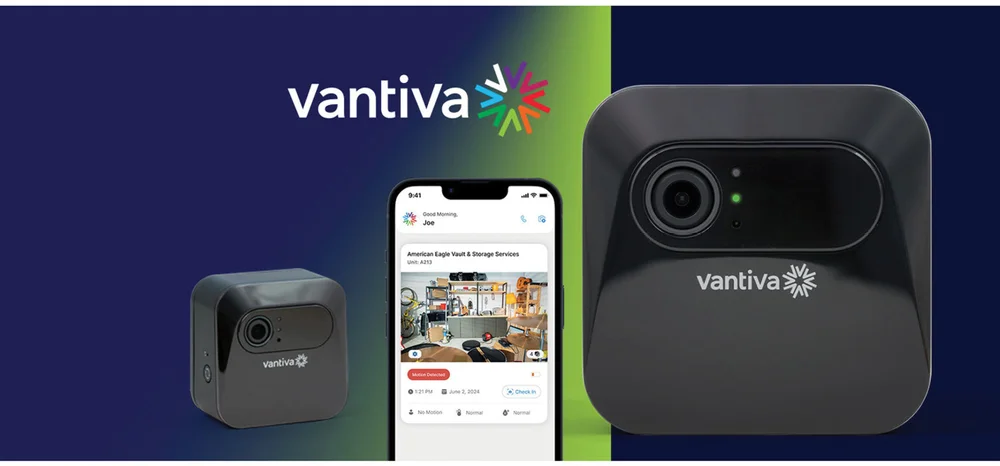 Vantiva has released Vantiva Peek™, a patent-pending smart camera designed for self-storage rental units that features integrated motion, humidity, and temperature sensors. Vantiva Peek is a complete in-unit monitoring solution, available exclusively from Vantiva’s self-storage operator partners. It allows renters to access live and stored camera images and live sensor data as well as receive real-time automated alerts via a monthly service subscription. Alerts and images are accessed through the Peek app; self-storage operators can choose to use the Vantiva-branded app, customize the app with their own branding, or integrate Peek into their existing renters’ app. In every case, the self-storage provider owns the customer relationship and earns recurring revenue for the lifetime of the service subscription. Vantiva Peek camera features include wide-angle lens to capture a clear view of the entire unit; night vision; long-range, low-power wireless technology; quick mounting with the built-in magnetic backing; and long battery life and easily replaceable AA batteries. For additional details, visit www.vantiva.com.
Vantiva has released Vantiva Peek™, a patent-pending smart camera designed for self-storage rental units that features integrated motion, humidity, and temperature sensors. Vantiva Peek is a complete in-unit monitoring solution, available exclusively from Vantiva’s self-storage operator partners. It allows renters to access live and stored camera images and live sensor data as well as receive real-time automated alerts via a monthly service subscription. Alerts and images are accessed through the Peek app; self-storage operators can choose to use the Vantiva-branded app, customize the app with their own branding, or integrate Peek into their existing renters’ app. In every case, the self-storage provider owns the customer relationship and earns recurring revenue for the lifetime of the service subscription. Vantiva Peek camera features include wide-angle lens to capture a clear view of the entire unit; night vision; long-range, low-power wireless technology; quick mounting with the built-in magnetic backing; and long battery life and easily replaceable AA batteries. For additional details, visit www.vantiva.com. -
Public Storage Loses LawsuitOn July 11, following a four-day trial, a jury in Middlesex County, N.J., awarded $2.5 million to Jane Bishop, a woman who injured her left arm from falling at a Public Storage facility in Monmouth Junction, N.J. Rejecting the defense’s suggestion that Bishop, 66, was prone to falling, the jury unanimously ruled that negligence by Public Storage was the proximate cause of her injuries. They awarded her $2.5 million for past, present, and future pain and suffering and attributed 100 percent of the damages to Public Storage. Bishop broke her left elbow on Jan. 9, 2020, when she fell at the entranceway to the facility’s office. An engineering expert who testified at the trial said the step leading to the entrance was in disrepair, wasn’t up to code, and had multiple defects, which caused her foot to get caught. Following the fall, Bishop, who’s left-handed, had her left elbow joint surgically replaced and underwent two carpal tunnel surgeries to alleviate swelling from the initial, injury-related surgery. According to Bishop’s attorney, Public Storage only offered a “nuisance value” settlement before the trial. At trial, the company took the position that it was not obligated to make repairs to the entrance, he said. An employee said in a deposition that the staff walk around the facility every day to look for trip hazards, and the company said Bishop had fallen at the site before that incident. Public Storage was represented by Colin Hackett of Lewis Brisbois Bisgaard & Smith in Newark, N.J.

